Mercedes-Benz eActros
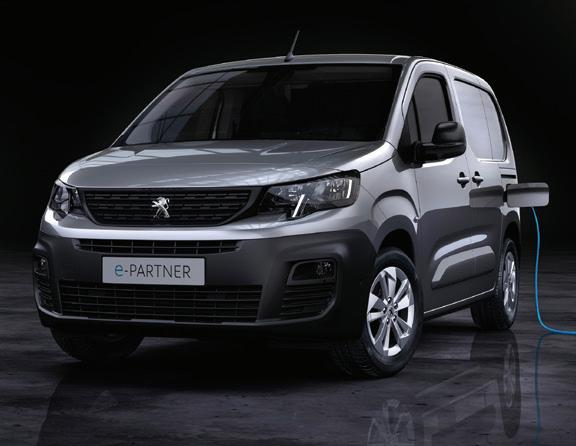

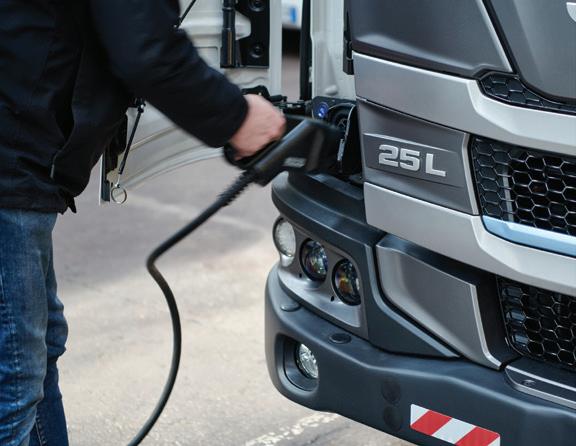
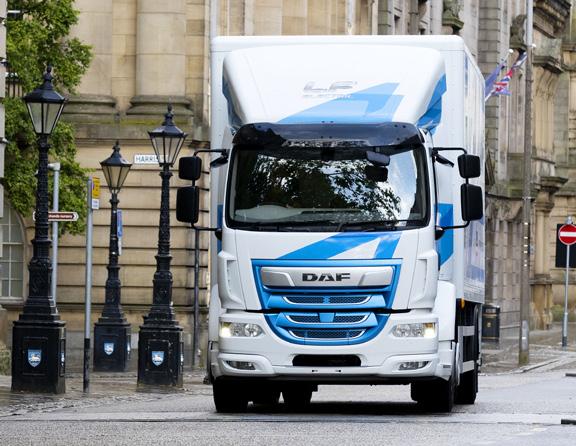

battery van round-up DAF LF driven in UK Scania transition volta zero first drive VEHICLES - MICROGRIDS - LOW EMISSIONS - RENEWABLES E SUSTAINABILITY-ENERGY-ENVIRONMENT-FUEL
IAA SHOW VAN DEPOT CHARGING MULTI-MODAL URBAN DELIVERY ISSUE TWO
RENAULT TRUCKS E-TECH
At Renault Trucks we are pioneers in electric vehicles. Our experience, and that of our expert partners, can help you introduce electric vehicles to your fleet, and reduce CO2 emissions to the benefit of us all.
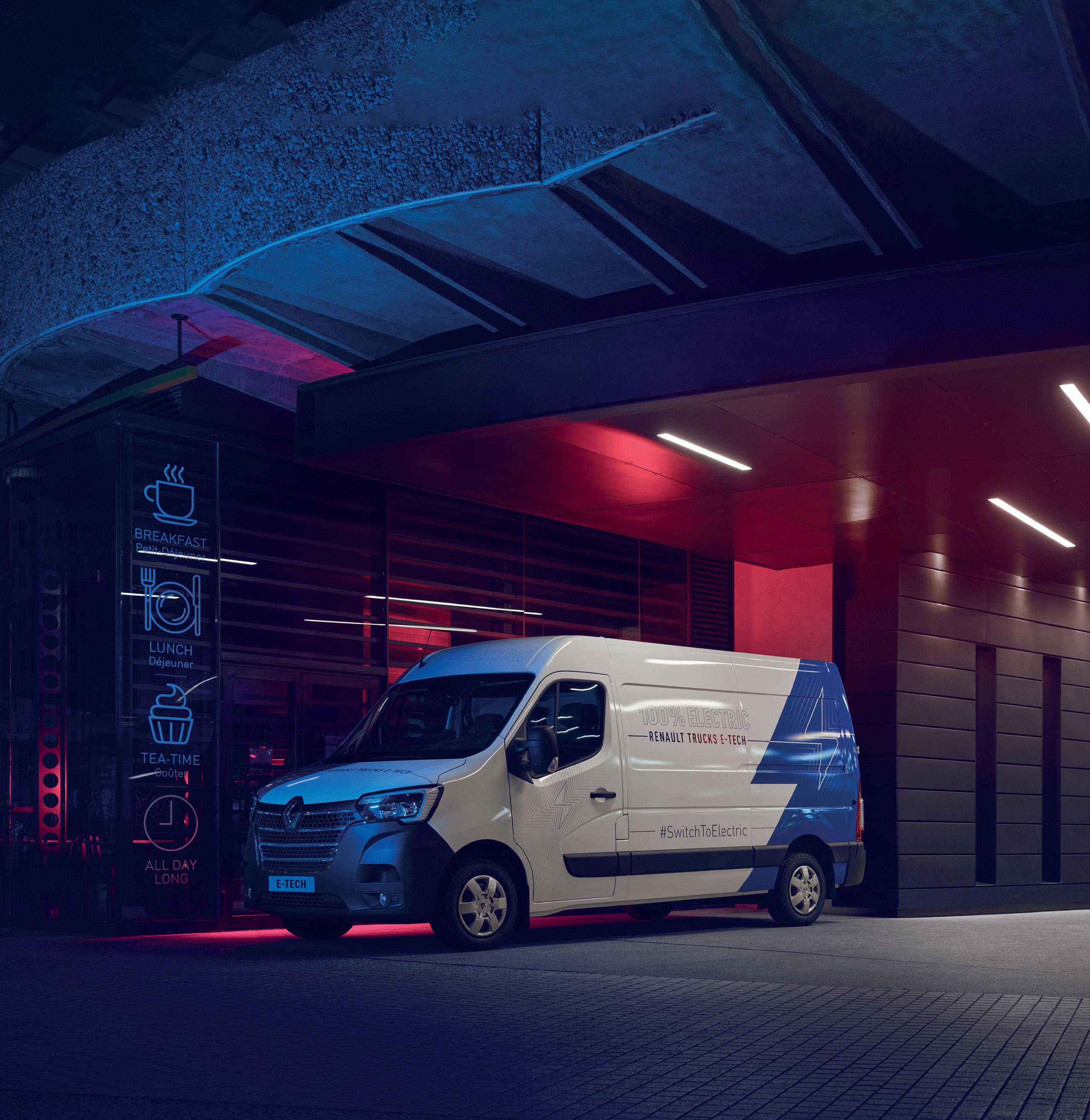
renault-trucks.co.uk
Welcome to issue two of Destination Net Zero Be green, not naïve
Talk about bad timing...
September 29 was World EV Day, and the following October 1 was the day that most UK households were warned that the average energy bill would increase from £1971 to £2500 a year. Government intervention means that we’ve actually got away lightly: without it the new figure would have been £3549.
It’s even worse for businesses who do not have the benefit of the domestic price cap: unless they have a fixed deal in place they could see a 400 per cent increase in electricity costs. As we went to press Government help for business had been promised but not quantified.
Pioneers of battery-electric vehicles are already bearing the cost. We hear of one fleet that has invested heavily in electric buses in the hope that the higher front-end and battery-leasing costs might be off-set with lower running costs, only to find that the cost of fuelling one of their remaining diesel buses for a day is rather less than it costs to charge up an electric one. Even the savings in maintenance costs are tempered by a higher pence per km tyre bill.
It’s not just a UK issue. Across Europe, it’s estimated that when the last diesel trucks, buses and coaches are retired in 2050, the capacity of the electricity grid will have had to be increased by 100 per cent to charge their battery-powered replacements. At the same time, the generation process itself will have had to have been decarbonised. Currently, gas and coal are Europe’s
second and third most important sources of electricity, with nuclear first. Wind, hydro, bioenergy and solar combined lag significantly behind the contribution from fossil fuels and their expansion will require huge investment in both financial and landuse terms.
Operators seeking to go fossil-free therefore face considerable short and long term uncertainties over electricity. And there are further doubts over the availability and cost of on-road charging. We already start to hear horror stories: one driver we know put £40-worth of electricity into his car using a road-side charger, and was surprised to see it had increased his range by just 26 miles. At least Dick Turpin wore a mask!
There’s a suspicion that some kind of discretionary/distress pricing might be in operation: if a charging provider can ‘see’ that nearby chargers are busy and the vehicle topping up has only a small range left then the temptation to pump the price up would certainly be there.
Providing on-depot charging for fleets is always an option, but making the massive investment required in real-estate and infrastructure is a big risk for operators large and small unless security of supply and stability of price can be assured. This isn’t a matter for industry, it requires a substantial long-term Government intervention.


There is also little sign of battery-electric vehicles (BEVs) getting cheaper than their ICE (internal combustion engine)
equivalents. Emissions Analytics, the researchers who first uncovered the ‘Dieselgate’ scandal, point out that price parity between BEVs and ICEs was initially projected to have arrived by now: but it hasn’t, and it won’t, because of steeply rising prices for rare earth metals.
Fortunately, BEVs are not the be all and end all of the transition to net zero. Modern diesel vehicles are clean and efficient, and will become even more so when Euro VII kicks in. Their carbon footprint can be reduced substantially if synthetic fuels such as HVO are used, although the need to source their feedstocks ethically will constrain supply. A wide range of biogas trucks are also available for heavy-duty longhaul applications.
Looming in the distance is a hydrogen-based economy: hydrogen is unbeatable in terms of energy per kg, although its production, transportation and storage poses challenges.
Battery-electric vehicles clearly do have a role to play on the road to net zero, but it would be very unwise to think that they are the only way this can be achieved. The reality is more likely to be that vehicle manufacturers have to offer a variety of solutions both to suit operational demands and to ensure that electrical generating facilities and distribution grids are not overwhelmed by demand they cannot hope to meet.
Matthew Eisenegger, Publisher

issue 2 | destination net zero 3
“Fortunately, BEVs are not the be all and end all of the transition to net zero”
ACCELERATE TO NET ZERO

WWW.GBF.LTD ULTRA LOW EMISSION FUEL DIESEL ENGINES RUN CLEAN AND GREEN ON Gd+HVO JOIN OUR HERO CLIENTS HELPING THE PLANET DROP IN FUEL SOLUTIONS HERE AND NOW
4 destination net zero | summer 22
INFORMATION
EDITORIAL
Publisher: Matthew Eisenegger
Editor: Richard Simpson
Harold Francis Callahan
Editorial Address: Commercial Vehicle
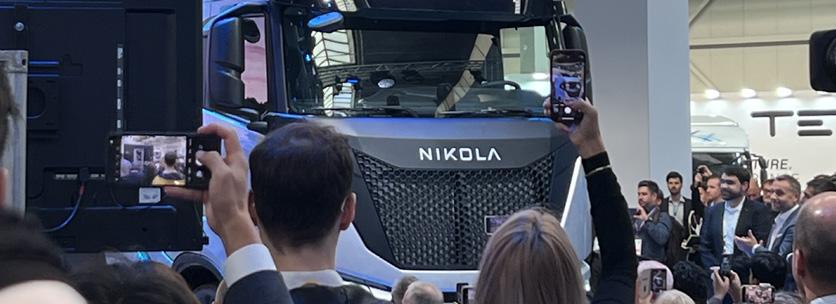
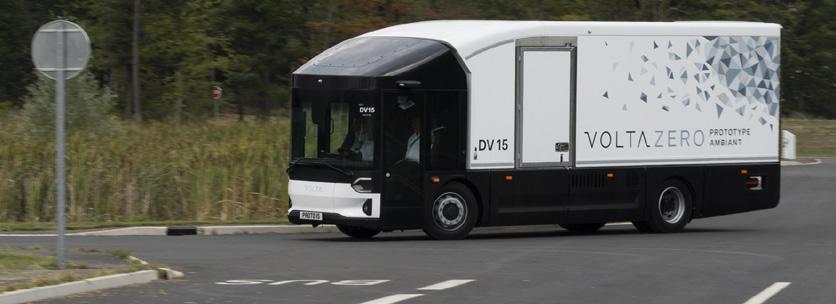
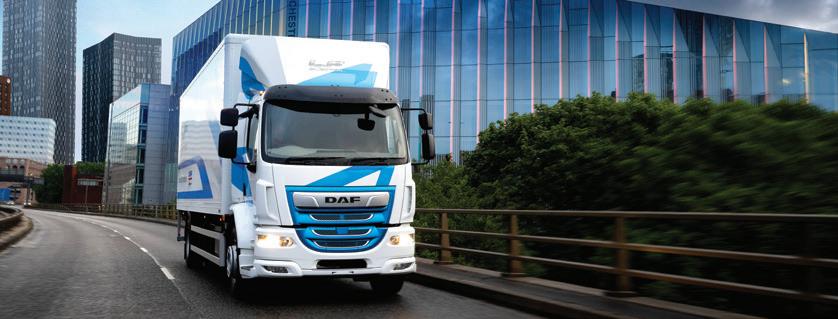
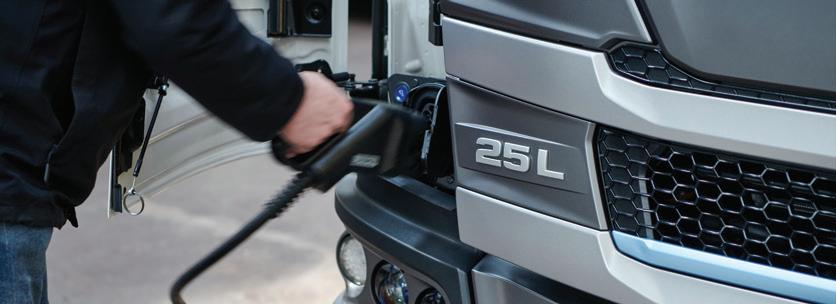


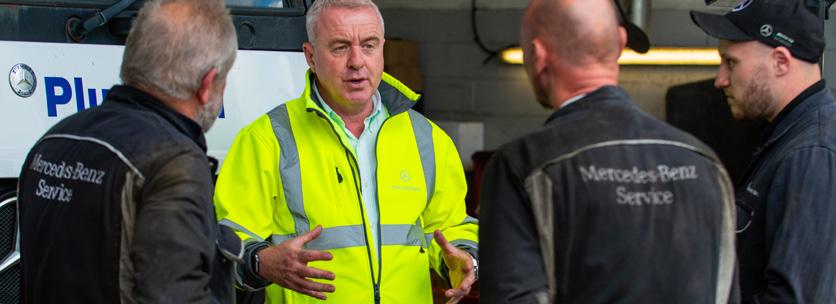

& Publishing Ltd, 4th Floor
Capesthorne Drive, Eaves Green, Chorley, Lancashire. PR7 3QQ
01257 231521
matthew@cvdriver.com
ADVERTISING
Advertising Sales: David Johns

01388 517906
07590 547343
sales@cvdriver.com
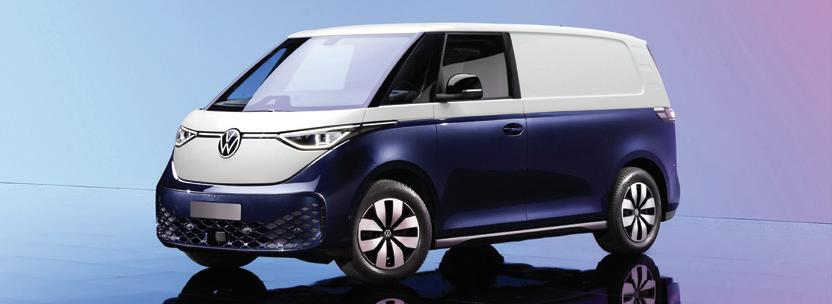
DESIGN
Art Editor: Harold Francis Callahan
01257 231521
design@cvdriver.com
CONTRIBUTORS Richard Simpson Steve Banner Grahame Neagus John Charle James Baker
PUBLISHED BY
Commercial Vehicle Media & Publishing Ltd, 4th Floor, 19 Capesthorne Drive, Eaves Green, Chorley, Lancashire. PR7 3QQ
01257 231521
publisher makes every effort to ensure
magazine’s contents are correct. All material published in Destination Net Zero magazine is copyright and unauthorised reproduction is forbidden. The Editors and Publisher of this magazine give no warranties, guarantees or assurances and make no representations regarding any goods or services advertised in this edition.
Net Zero magazine is published under a licence from Commercial Vehicle Media & Publishing Ltd. All rights in the licensed material belong to Matthew Eisenegger or Commercial Vehicle Media and Publishing Ltd and may not be reproduced whether in whole or in part, without their prior written consent.
Net Zero Magazine is a registered trademark.
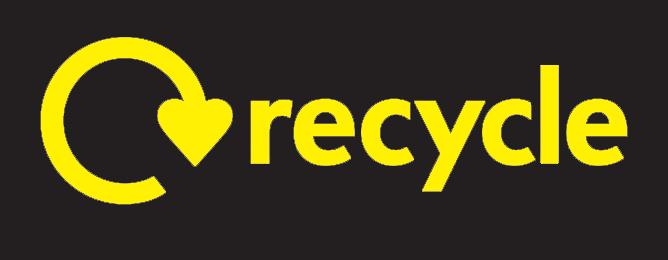
Contents
issue 2 | destination net zero 5
Managing
Designer:
Media
19
Telephone:
Email:
Telephone:
Mobile:
Email:
Telephone:
Email:
Telephone:
If you are not going to keep this magazine for future reference please pass it on or recycle it. NOTE The
the
Destination
Destination
14 – 15 Thought Leadership Grahame Neagus’ thoughts on multi-modal urban delivery 16 – 19 Mercedes-Benz eActros Going electric with the threepointed star 20 –23 Small EVs Electirc light van round-up 26 – 28 Steve Bridge & Mercedes-Benz eStar Forward looking Mercedes dealer 30 – 33 DAF LF First electric truck from UK’s market leader 34 – 37 Scania - Your Space Preparing the ground for zero emissions 42 – 45 Volta - Zero first drive New kid in town 6 – 8, 10 & 12 NEWS Government action needed on grids MAN’s electric lion Cummins fuel-agnostic engines
Latest news and updates
two months
Government intervention across Europe is required if the batteryelectric heavy trucks developed by leading manufacturers are to be viable for operators, two senior industry figures have said.
Christian Levin, the CEO of Scania and MAN parent Traton, and Karin Rådström, Daimler Trucks director for Europe and South America, were both speaking at the IAA Show in Hannover.
Mr Levin said that Scania had developed a wide range of batteryelectric vehicles from urban delivery trucks to vehicles operating at gross weights of 74 and 80 tonnes, and was decarbonising its own supply chain regarding the supply of batteries, steel, aluminium and iron.
Traton and Daimler had partnered with Volvo Group to set up a joint venture Commercial Vehicle Charging Network Europe enterprise with the aim of creating 1700 electric truck and coach-


specific charging points at key locations across Europe. Total investment was €500 million.
Mr Levin added that the European anti-trust authorities had been obstructive to the network’s formation, even though the charging-points would be open to all makes of vehicle. “The current spike in electricity prices is temporary, and rising carbon prices will push operators towards electricity. The question is can we in Europe expand the generating grid fast enough? The vehicles are ready, but the grid is not.”
Karin Rådström agreed that the electricity pricing crisis would ease in the next two years, but the transition from diesel might have to be helped by CO2 taxation and more subsidy for electric vehicles.
“Customers will be driven away from diesel by higher prices,” she said.

6 destination net zero | issue 2
Everything you need to know from the last
• Christian Levin, the CEO of Traton
• Karin Rådström, Daimler Trucks director for Europe and South America GOVERNMENTS MUST ACT OVER CHARGING NETWORKS
MAN ROLLS OUT ‘ELECTRIC LION’A pre-production electric heavy truck formed the centrepiece of MAN’s stand at the IAA Show. Twenty such vehicles have been built at MAN’s facility in Munich and are undergoing trials. Production trucks are due to go into service in 2024, and
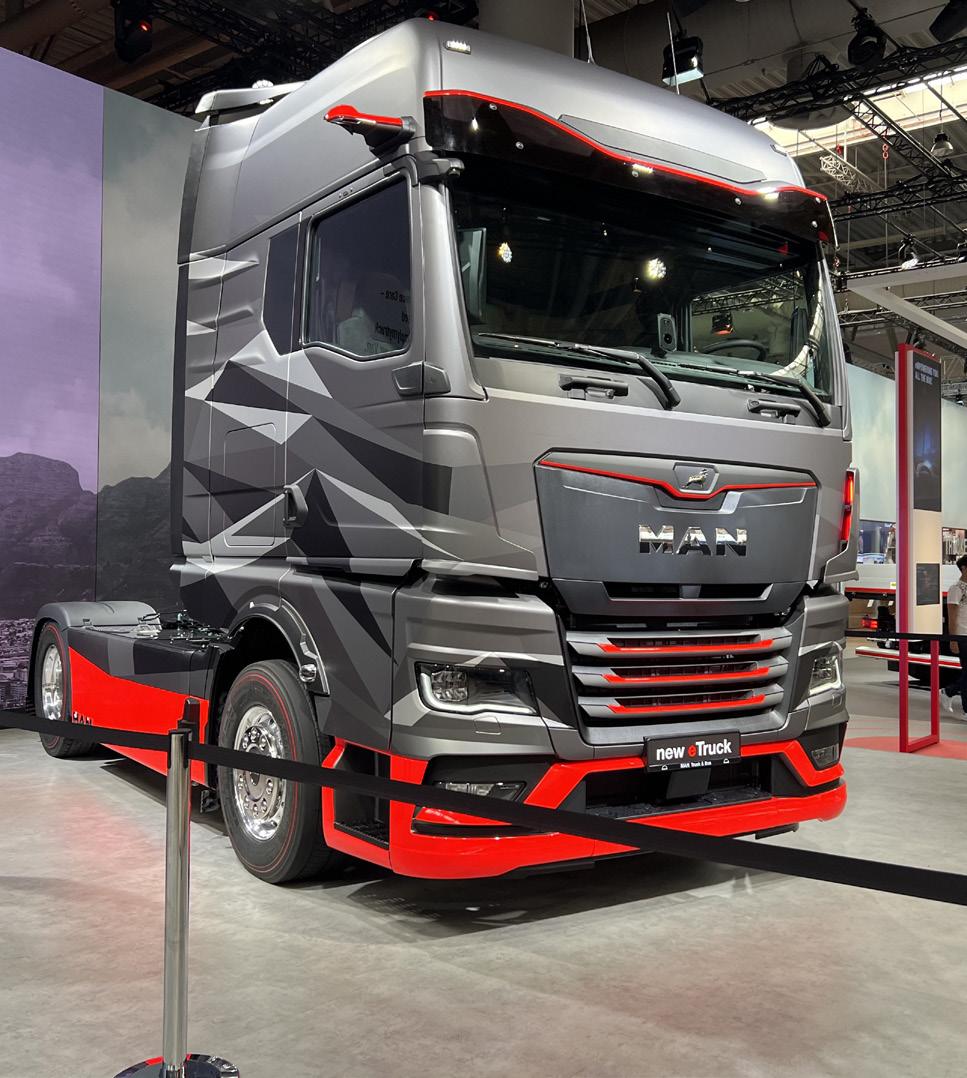
feature preparation for a future generation of mega-chargers.

Alexander Vlaskamp, CEO of MAN Truck & Bus, said: “Demand for electric trucks is ramping up. We are opening the order books for the 50-tonne e-truck today. It will have a 600 km range, and 80 per cent recharge in less than an hour. Tippers, fridges and cranes are all possible with e-power.
“At the start of production, our new eTruck will cover all application areas, whether for the regional distribution of organic milk or long-distance transport of green steel. We will support our customers as closely as possible in their transition to e-mobility, based on our many years of expertise in the field of e-buses and vans as well as our electric eTGM in distribution transport.”
The e-trucks will be built on the same production line as diesel models during the transition period.
“In terms of total cost of ownership, electric trucks will be better by the second half of this decade,” he said.

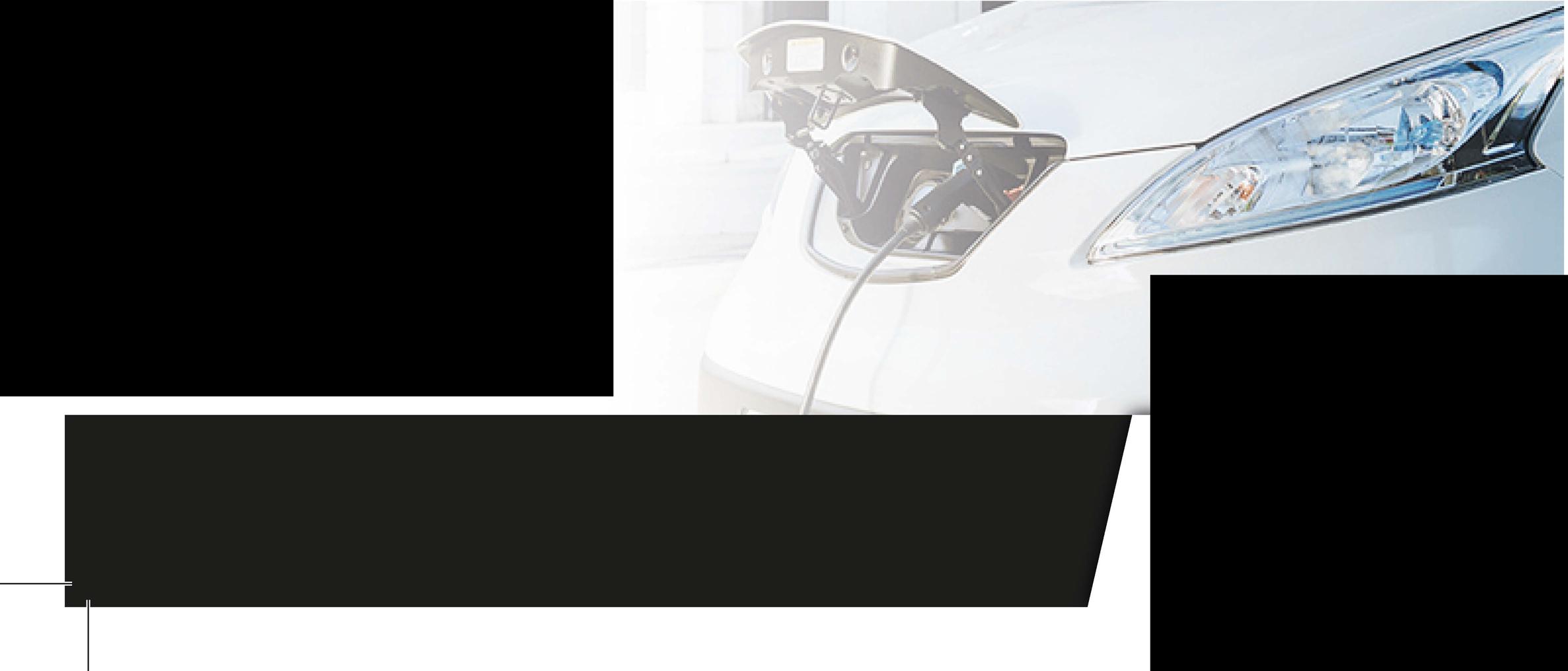
\Vwebfleet Our digital journey to a sustainable transport future Visit pages 24 - 25 �RIDGESTOnE Solutions for yourjourney
will
issue 2 | destination net zero 7
Latest news and updates
Everything you need to know from the last two months
CNG Fuels cooking with gas
Gas fuel supplier CNG Fuels has launched a bio-methane road fuel product, which it claims is 40 per cent cheaper than diesel and reduces CO2 emissions by 70 per cent.
Retailers John Lewis/Waitrose and Argos are customers for their own-account fleets are customers, as is third-party haulier Brit European.
CNG’s bio-methane will sell for 65p/kg + VAT: the equivalent of buying diesel at 48p a litre, the company said. Iveco, Scania and Volvo all currently offer gas-burning trucks in the UK, but the technology has been rejected by DAF and Mercedes-Benz.
Every building an energy microgrid
Electrifying the commercial vehicle fleet is likely to see demand for electricity double from what it is today by 2050, according to power-control specialist Eaton.
Buildings, especially commercial buildings, will play a vital role in capturing energy through solar panels. Eaton says this energy can be stored in second-life vehicle batteries (which still have around 70 per cent of their ‘new’ capacity), then used to charge vehicles as they load, unload or are parked at the end of a shift.
Eaton’s acquisition of Swiss company InMotion enables it to offer a solution that includes energy storage, recharging and energy management. It can provide a modular scalable solution using solar panels and batteries to store 750 kW/h of energy and recharge at 200 kW/h.
MULTI-FUEL ENGINES
Strategic takeovers by Cummins of brake and axle manufacturer Meritor and Jacobs of Jake Brake fame indicate that the company is expanding from being an engine specialist into a broad footprint in diverse power solutions. At the IAA, it showed new generation engine platforms with potential to run on diesel/HVO, methane, or hydrogen. A different specific cylinder head for each fuel was displayed.
Besides conventional axles and braking systems (and a valuable customer list), Meritor brings Cummins integrated e-axle designs, which free up undercab space for sophisticated electrical control and power-take off systems, and create more room for batteries.


Cummins is also building its own fuel cells and hydrogen electrolisers, and it showed a complete Mercedes Atego distribution truck with a Cummins B6.7H hydrogen-powered engine installed in place of the standard Daimler diesel. Just 40 kg of hydrogen will take the 290 hp truck 500 km, and there is no loss of loadspace. Cummins said the entire project took only three months to complete, and the standard transmission and cooling systems are retained.
A Cummins spokesman explained that there was no one answer to decarbonising transport, and introducing hydrogen combustion engines would help boost the hydrogen industry and indirectly aid the introduction of fuel cell trucks.
8 destination net zero | issue 2
• Four fuels, three heads, one engine CUMMINS’


Electrifying efficiency. The new eActros. Charged & Ready. Find out more.
Latest news and updates
Everything you need to know from the last two months
• Nikola’s European debut drew a crowd
Plan before purchasing electric vehicles
Operators should asses their infrastructure and plan for the future before they consider purchasing electric vehicles, Denise Beedell, Logistics UK’s public policy manager, told the organisation’s Transport Manager conference.

That planning had to start with property, she said.
Operators needed to check that their tenure on leased depots was long enough to make installing the necessary electrical power worthwhile.
If a move was necessary, then “suitable sites will command premium rents,” she warned. Space would be needed to park electric vehicles for long periods of time while charging, and big fleets and those with heavy
vehicles would need better-thanstandard power supply.
“Phase the introduction of electric vehicles, but ensure that enough cables are laid to service the entire fleet, even though you should only install enough chargers for your initial needs,” she advised.

Operators should realise that not all public chargers could be accessed by large vehicles, and they should consider installing solar panels, battery storage and vehicle-to-grid facilities to help manage costs at their own depots.
Drivers who were keen to try electric vehicles should be the first to get them, be trained, and become ‘electrification champions’ in the company.
NIKOLA ELECTRIC TRUCK MAKES DEBUT AT IAA
Iveco’s stand at IAA featured the first appearance in Europe of the Nikola heavy truck.
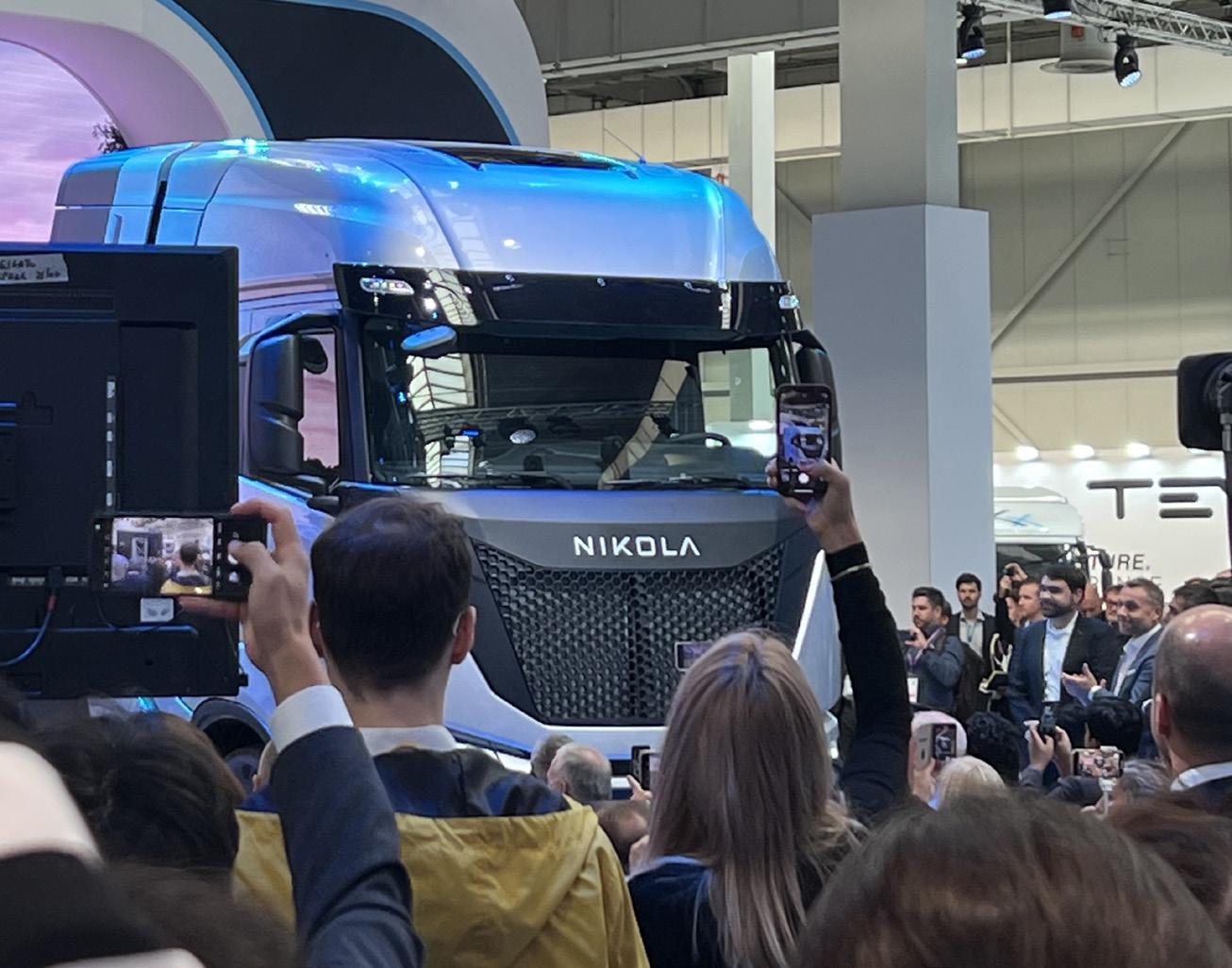
Based on Iveco’s S-Way chassis-cab, it is said to be the first Class Eight (36-tonne GVW) battery-electric truck to operate in the USA, and pre-production examples are also working in Hamburg Docks in Germany.
Hydrogen fuel-cell versions have been in operation in Los Angeles since January, and they share the majority of parts with the battery-electric version. Nikola claims that, even at this early stage, downtime is less than for equivalent diesel trucks. Maximum engine output is the equivalent of 645 hp and range is 800 km. A full production version of the fuel cell Nikola will be released next year.
• Denise Beedell, Logistics UK’s public policy manager
10 destination net zero | issue 2
Electrification changes everything but our promise
You’ve always been able to rely on Scania for a complete tailor-made solution for your business – and that’s not going to change.
With electrified solutions there are new pieces to the puzzle that may seem complex, like charging infrastructure, and environmental incentives, but you don’t have to figure it out on your own.
We promise to be by your side every step of the way. From initial operations analysis

and planning, through implementation to long term ongoing operation – ensuring you have a charging solution that can scale as your fleet grows.
With Scania, you will get an electrified solution that not only makes sense for the environment, but also your business. So if you have the drivers, our solution covers the rest. And that’s a promise you can count on.
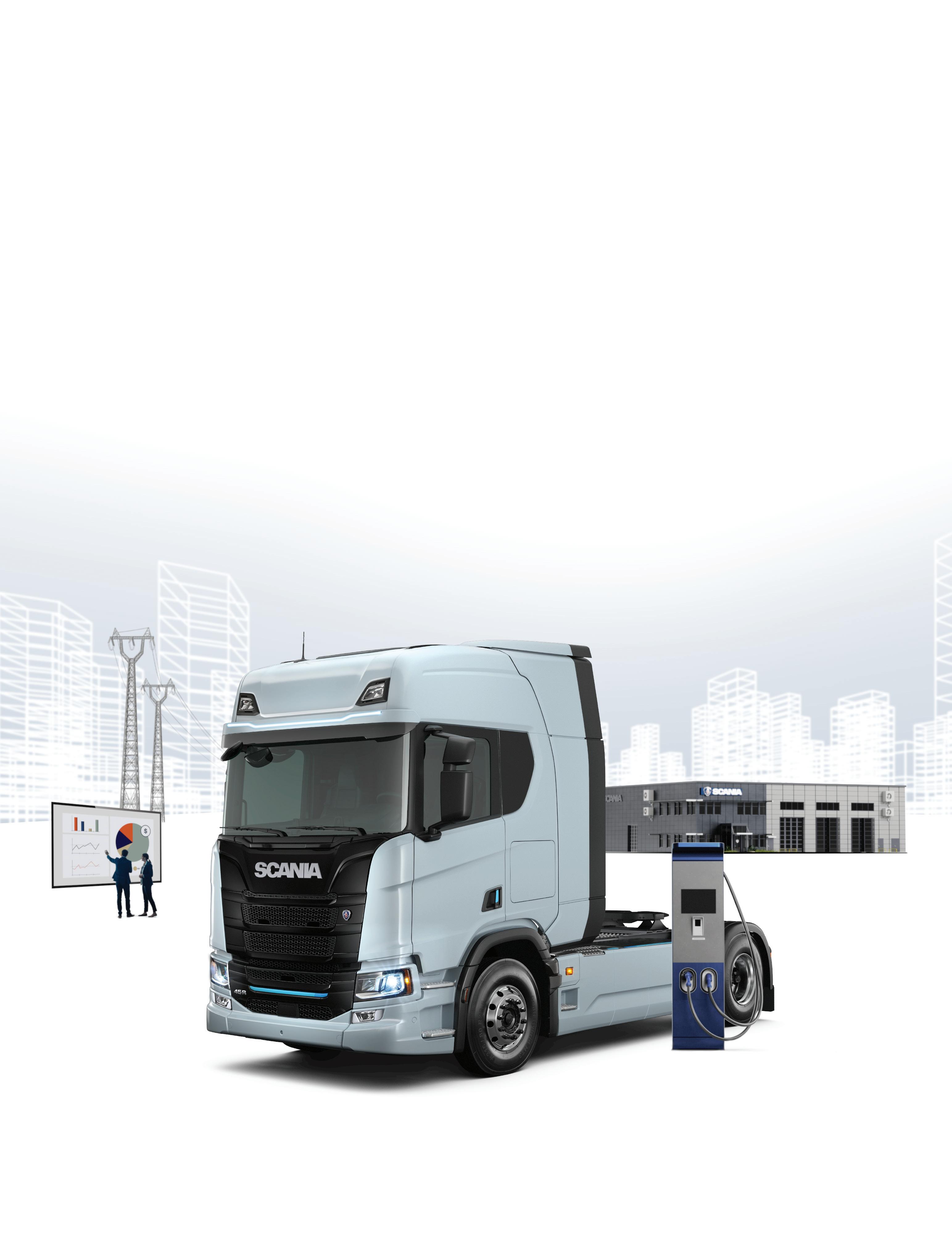
VISIT SCANIA.CO.UK TO LEARN MORE ABOUT SCANIA’S ELECTRIC SOLUTIONS
Legal Updates

Highway Code - A new section for self-driving vehicles
From 1 July new rules on the use of self-driving vehicles in Great Britain came into force. The changes are included in a new section in The Highway Code which can be accessed for free on GOV.UK.

At the moment, only vehicles with advanced driver assistance systems are available in the UK. Currently, there aren’t any vehicles in Great Britain which have been classed as self-driving however this could change as soon as next year. Any that are classed as self-driving will be listed on GOV.UK.

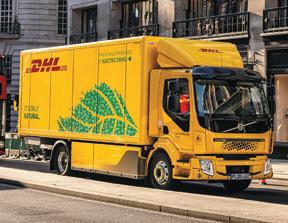
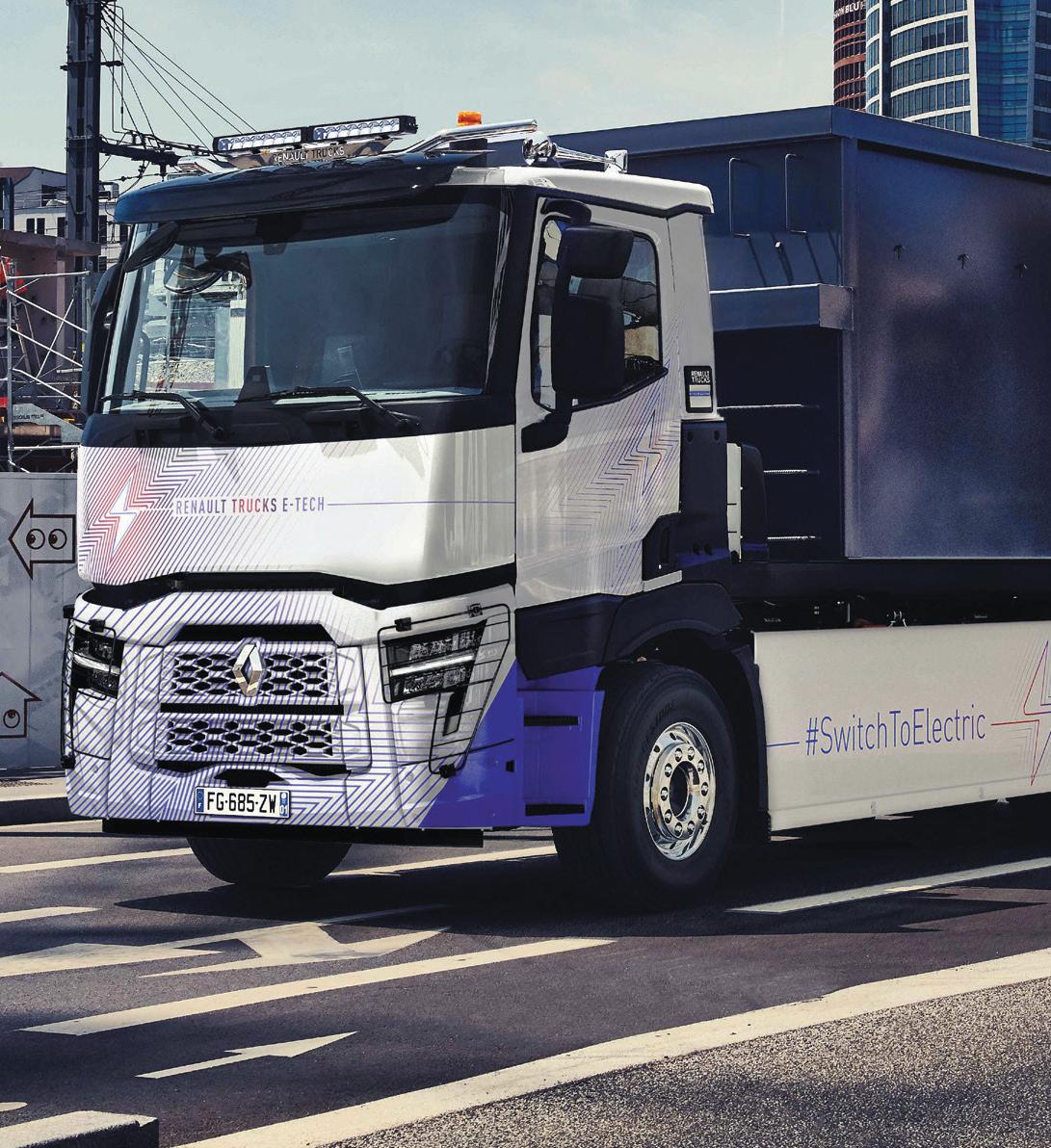 Words: Backhouse Jones
Words: Backhouse Jones






What has changed in the new section?

According to DVSA, the changes to the Code will help ensure the new technology will be used safely, explaining clearly that while travelling in self-driving mode, motorists must be ready to resume control in a timely way if they are prompted to – such as when they approach motorway exits. It also includes details about appropriate insurance needed for selfdriving cars.
The plans also include a change to current regulation, allowing drivers to view content which is not related

to driving on built-in display screens, while the self-driving vehicle is in control. Please note, it will however, still be illegal to use mobile phones in self-driving mode, given the greater risk they pose in distracting drivers as shown in research.

The government is working with the manufacturer, retailer and leasing industries to ensure that anyone accessing a self-driving vehicle will receive advice on how to use it.
Stay up to date It’s important that everyone understands their responsibility for their own safety and that


of other road users. You can read the full version of The Highway Code is available, free of charge, on GOV.UK.
The Highway Code is updated regularly so it’s really important you keep up-to-date with changes. GOV.UK includes a list of the latest updates that have been made, so it’s quick and easy to see what has changed. If you’ve not already done so, you can sign up to receive email updates of any future Highway Code changes.


Please contact the regulatory team for any advice on 01254 828300.



Renault
the fast-moving world
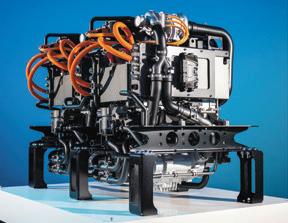
12 destination net zero | issue 2
e-van update hvo drop in and go hydrogen on the highway installing infrastructure INFORMATION - EMISSIONS - RENEWABLE ENERGY - NEWS E SUSTAINABLE-ENERGY-ENVIRONMENT-DATA
Trucks E-Tech NEWS & REGULAR FEATURES TECH UPDATES FUTURE FUELS LAUNCH ISSUE E In
of environmental change, brand new publication Destination Net Zero captures the latest news, views and intelligence in this vitally important transport and logistics sector. Core content covers all emerging fuel technologies, as well as fuel enhancement products and services, including all infrastructure considerations. Destination Net Zero will also call on a pool of industry experts offering sound advice, thought leadership and honest opinion. This multi-media publication will be distributed via a specialist database and also subscription and strategic distribution partners in both hard copy print and digital media channels. It will target the key people within the transport and logistics sector who have environmental change front and centre in their procurement process for both hardware and its supporting infrastructure. When viewed via smartphone, Destination Net Zero also utilises the latest AR (Augmented Reality) software, allowing the use of supporting video media to further enhance the magazine experience. Destination Net Zero is also fully supported by all main social media network channels as well as the very latest online page turning software. “The journey towards a cleaner transport world has started. Join us for Destination Net Zero.”E Click me to read the latest issue E Visit the DNZ website: www.destinationnetzeromagazine.com
Allison eGen Power ®
Introducing
a new
series of fully integrated electric axles from Allison Transmission. Allison’s eGen Power® series is designed to fit between the wheels of medium and heavy-duty trucks and buses, replacing the vehicle’s traditional powertrain.
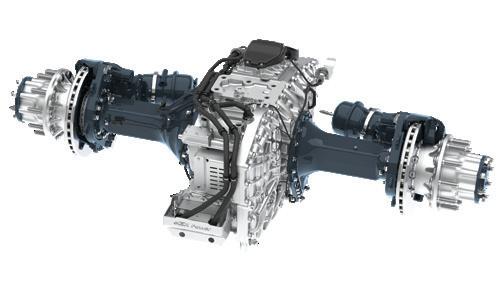
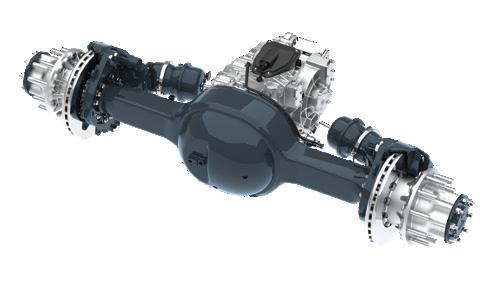
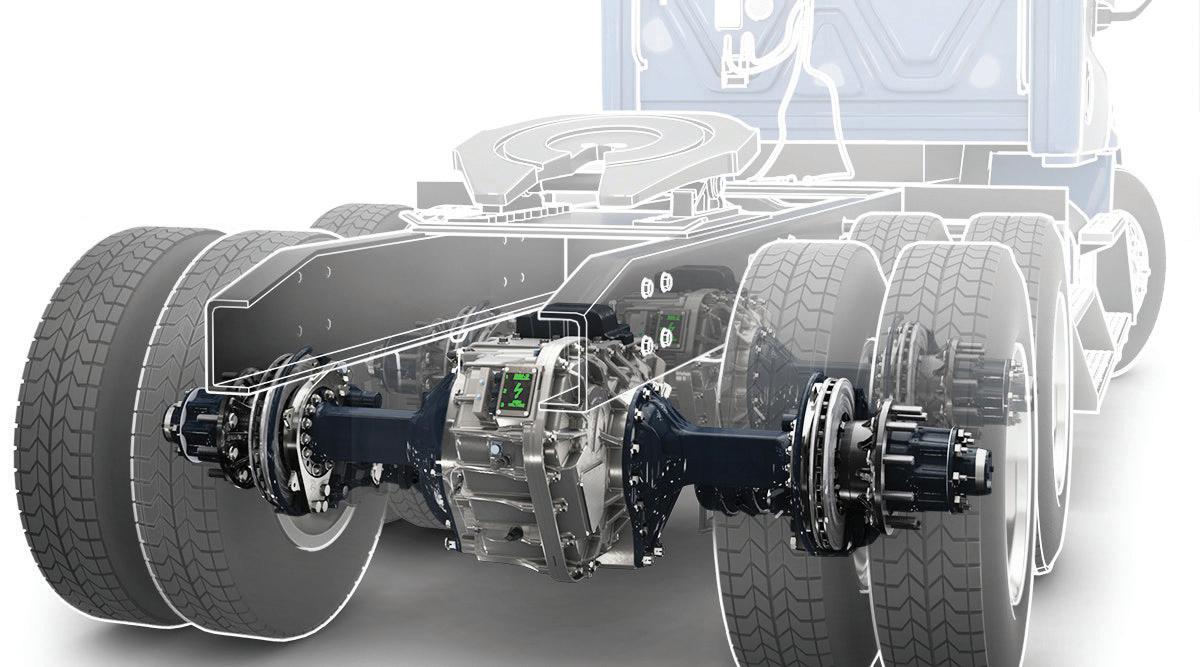
eGen Power is a bolt-in solution compatible and easily customizable to your current vehicle frame, suspension and wheel ends, and is well suited to most OEM vehicle assembly processes. The eGen Power series features fully integrated electric motors, a multi-speed gearbox, an oil cooler and a pump, providing industry-high performance and efficiency. The system is compatible with full battery electric vehicles (BEV) and fuel cell electric vehicles (FCEV) as well as range extending hybrid applications.
•
The first product launched, in 2020, was the eGen Power 100D, a dual-motor product aimed at 23,000 lbs (10,433 kg) axle rating.
•
Two additions to Allison’s e-Axle portfolio were announced in 2021: the single-motor 100S, also with a 23,000 lbs (10,433 kg) axle rating, and the dual-motor 130D, designed for the 28,660 lbs (13,000 kg) gross axle rating required by many commercial vehicles in European and Asia Pacific markets
TM
Driving the future of electrification.
With the increased focus on zero emission transportation, fleets want to drive cleaner and quieter vehicles without compromising on driver comfort and control, performance and reliability. Allison presents eGen Power TM , a complete electric propulsion system for vehicles from 10t to 13t Gross Axle Weight Rating (GAWR). Our portfolio of single and dual motor fully integrated axles works with a range of power sources and is designed for maximum performance, acceleration, efficiency and space saving. Using standard components, these e-Axles can be easily installed around the existing chassis and vehicle systems. eGen Power’s parallel gear architecture offers enhanced efficiency and performance, providing a longer range and more power.
Contact Allison for more information on how to get electrify your trucks and buses.


© 2022 Allison Transmission Inc. All Rights Reserved. allisontransmission.com eGen Power™ 100D / 130D eGen Power™ 100S / 130S
7031 Allison Electrification Ad 135mm h x185mm w Destination New Zero.indd 1 27/07/2022 12:36
Not just vans - Beyond common thinking
Grahame Neagus, Head of LCV, Renault Trucks UK & Ireland
It matters not
whether you are in London, Glasgow, Paris or Amsterdam, transport efficiency is under increasing pressure as the demand from society increases, in terms of volume of goods moved and environmental consciousness. With growing congestion and pressures to reduce emissions, Grahame Neagus, Head of LCV at Renault Trucks UK & Ireland, takes a look at what can be done today to achieve a reduction in both whilst improving logistical efficiency.
While the fiscal viability of electric vehicles becomes ever more attractive in the face of rising fuel prices and the climate crisis, this is only one part of the story. With all sizes of vehicles up to 40 tonnes now available as zero emission, the products from OEMs like Renault Trucks are readily available for operators to make the switch. Electric vehicles are no smaller in size than a conventional vehicle which is a good thing in terms of loading abilities, but road congestion remains at an all-time high, journey times are ever increasing and, as a result, the drivers who spend more time stuck in traffic are less productive.
In order to optimise logistical efficiency, it is necessary to relook at exactly how we all use a shrinking road space in order to deliver greater volumes of goods in a time sensitive manner and with zero emissions.
There is no doubt that to maximise both business profitability and sustainability, innovation will give us the resilience we need; looking at proper multi-modal integration is something we need to embrace in order to make a viable difference today.
Earlier this year at the ITT Hub expo in Farnborough, Renault Trucks launched two new vehicles, both based on the existing Master E-Tech, in response to the ever-growing emissions crisis within the transport sector.

The first of these was the Bee-Box concept on an electric Master Red Edition Platform Cab with a low loading platform body and taillift that transports and delivers mobile secure storage lockers for post and parcels in the inner city in order to take larger vehicles off the road. This concept is winning hearts and minds in Paris and if all goes well, it could well be rolled out across other European cities.
The other vehicle, OptiModale; is a three or four transportation solution in one vehicle, comprising an electric cargo Luton Box body housing an e-cargo bike and a fully autonomous e-cargo drone with the option of also carrying cargo robots too. Driven into a city, loaded with descending sizes of parcels, the OptiModale concept is able to execute three modes of transport simultaneously: the van remains on the less congestion outer extremities, whilst allowing the eCargo bike to transverse the inner city and the drone to delivery time sensitive packages elsewhere.
Of course today, here in the UK, the electric van and cargo bike work brilliantly, while the drone has more restricted capability due to CAA flying regulations. Yet in other global markets, this innovative, multimodal approach is already taking off and drone technology is
being seen as the way forward for smaller packages being effectively and quickly delivered, especially in hard to locate or reach areas. There is no silver bullet in being able to provide the ultimate solution but what is certain that being able to see the wider picture and understanding how you integrate the wider aspects of logistics into your operation makes everyone is a winner.
Our last mile challenges are never easy: the climate issue will not go away; legislation is requiring action. And while electric or hydrogen appears to be the most logical answer, we also need to free up road space to drive efficiencies, and Government needs to be committed to help operators test innovative technologies. A number of the main protagonists in the air sector are pushing for greater allowances in this field and in Coventry, the UK’s first ever Drone Port is already being built.
At Renault Trucks we see and understand that there is no one solution that will fit all demands and so when we are looking to assist in the final mile delivery, the combined choices that a vehicle such as OptiModale can offer is just one tangible way forward. The drone revolution is already here, with Royal Mail flying deliveries to the remote islands in Scotland and urgent medical supplies can be dispatched by drone to the Isle of Wight. Trucks and vans are not going away, but they will be an integral part of the new multimodal logistics future and that is very exciting for all concerned.
14 destination net zero | issue 2






issue 2 | destination net zero 15
“Here in the UK, the electric van and cargo bike work brilliantly”
• Grahame Neagus
• Renault Trucks E-Tech Master Optimodale
The future is now!
Words: John Charle

Electric is big news
these days, and Mercedes-Benz just one of many OEMs in the process of wheeling out a full range for our inspection. This time it was the turn of eEconic to make its trade fair debut at the IFAT Environmental Technologies 2022 show in Munich, alongside an eActros complete with fully-electric skiploader gear. But that isn’t all these particular Germans have been up to –there’s an updated diesel Actros too, the Actros L.
Econic is used for a whole rake of applications these days, particularly in London, where its Five-Star DVS rating makes it especially attractive. But the name conjures up “bin wagons” in most peoples’ mindssurely one of the most obvious places to start deploying clean, quiet electric vehicles. Due to enter series production in the second half of this year, eEconic –which is based on eActros - has already been trialled in daily use by German firm FES Disposal Services in Frankfurt (FES Frankfurter Entsorgungs- und Service GmbH) to great success.
A six-wheeled example, the displayed truck came with a MAM of 27-tonnes – including the extra 1000kg electric goods vehicles are permitted, to account for battery weight. It also featured Mercedes’ e-axle, which carries two integrated electric motors to directly drive
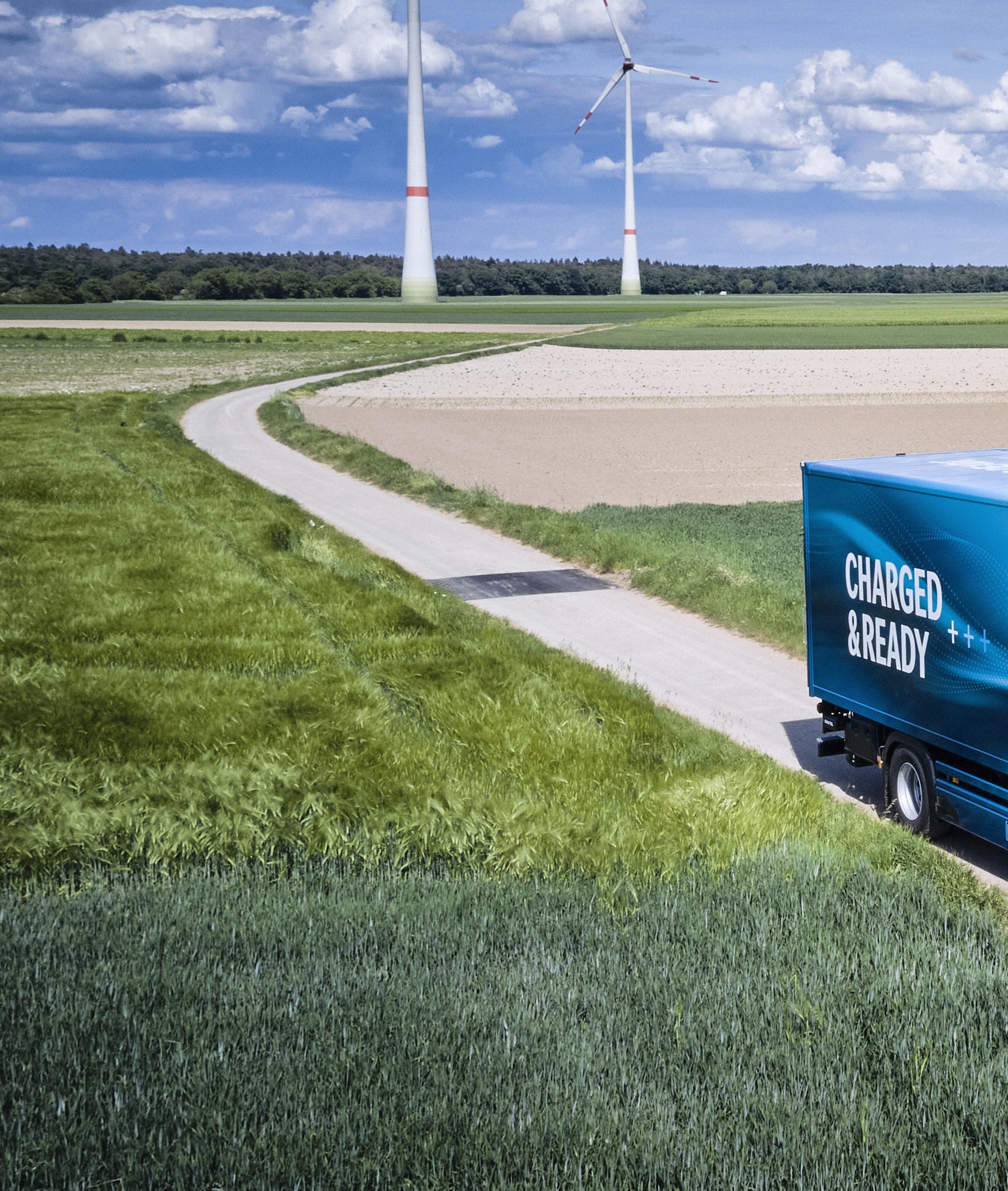
16 destination net zero | issue 2
“eEconic can be charged with up to 160kW, which means its three battery packs need just over an hour to go from 20 to 80 percent full”
Mercedes-Benz Trucks is set to start trials of the eActros on public roads this year before the planned on sale date of 2024.
the vehicle, removing the need for the weight, complexity and inherent efficiency losses that come with a traditional prop shaft. With no engine or tunnel required, this means the already low Econic floor is now completely flat, making cross-cab access even easier for crews regularly entering and exiting the vehicle.

The power source for this series-production model takes the form of three battery packs, which we’re told have an installed capacity of 112kWh apiece, 97kWh of which are usable. For those to whom that means nothing – which, hands up, includes us to a certain extent, this technology being in its infancy – we’re told this means: “The e-truck can cover the vast majority of typical Econic waste collection routes in single-shift operation without intermediate charging.”
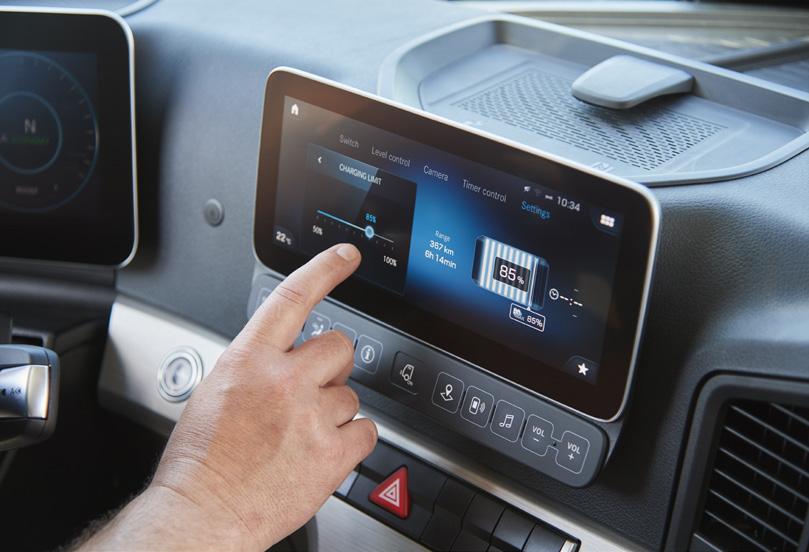
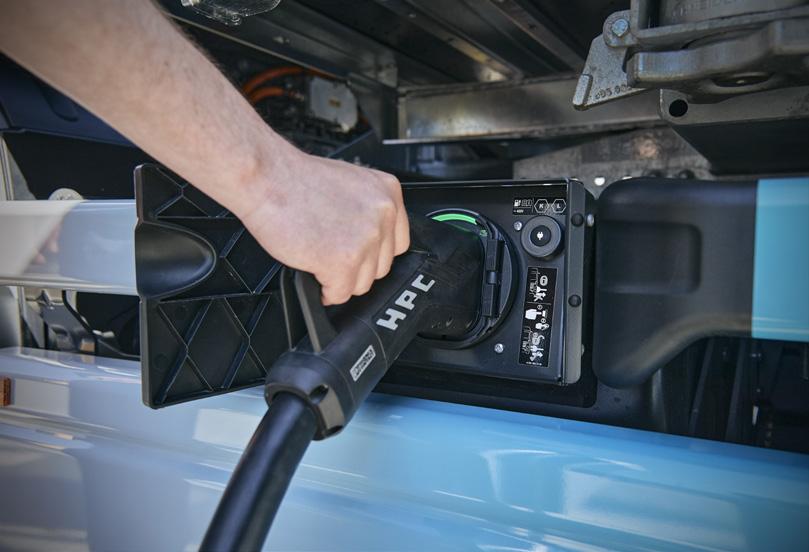
When the vehicle does return, eEconic can be charged with up to 160kW, which means its three battery packs need just over an hour to go from 20 to 80 percent full using a “standard” DC fast charging station, delivering 400A of current. The waste collection body on the IFAT display model was the Medium X4 22.5 Clean drive from Zöller, which has been designed specifically for electric chassis like eEconic.
cont.
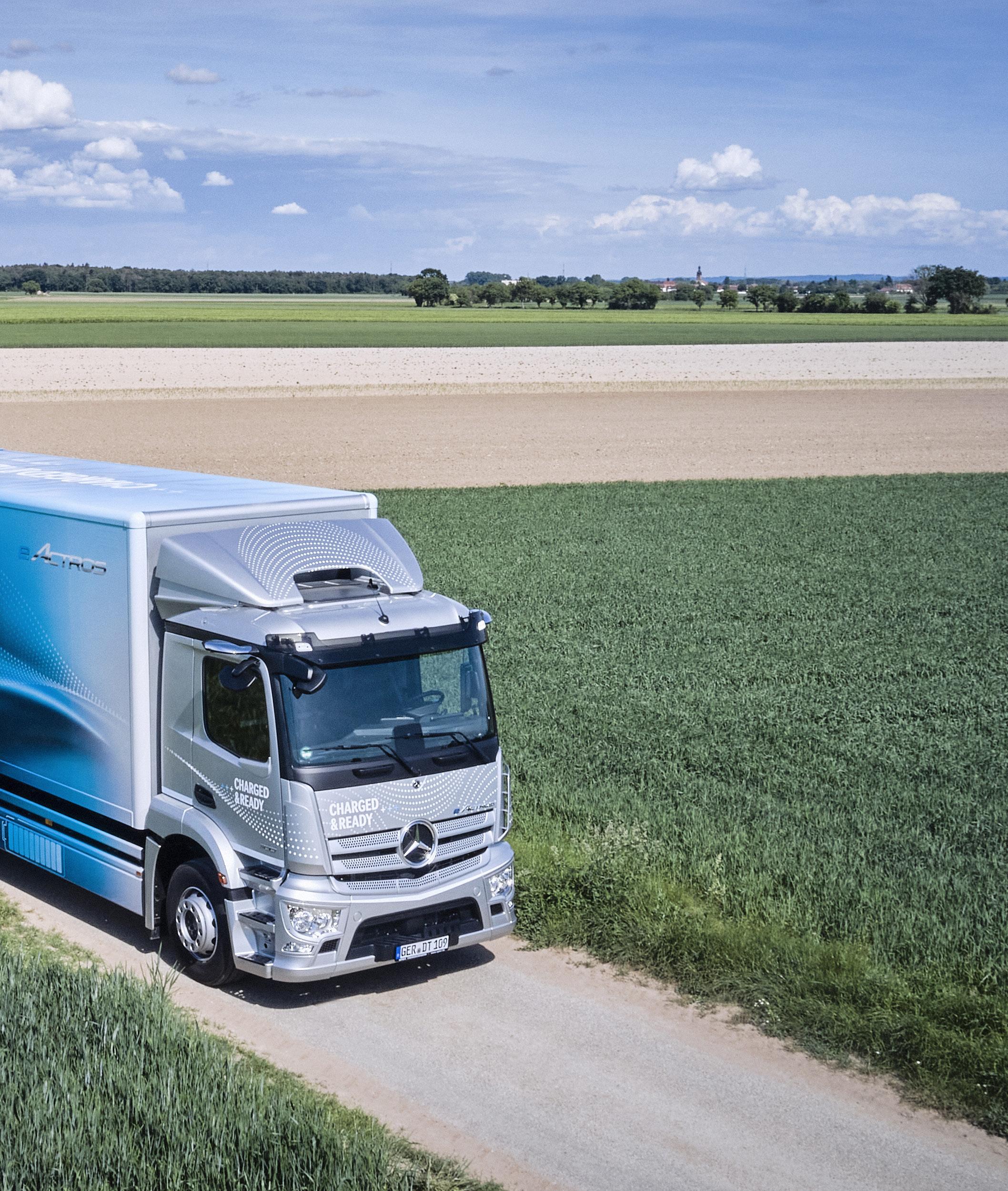
issue 2 | destination net zero 17
• Standard DC charging is used • Screen monitors battery state
Also displayed at IFAT was an all-electric skiploader, built on an eActros 300 chassis, part of a pilot project run by Mercedes, ZF and Palfinger. For us, the most interesting part of this was ZF’s electrified PTO, eWorX. This takes an electric motor, inverter, ECU and application-specific software and integrates them into one box, giving what is effectively a plug-and-play solution.
The DC power for eWorX is drawn from the traction battery of the eActros, and is used to drive the hydraulic pump needed for Palfinger’s skip gear - there’s no mechanical connection between the two. They do still talk to each other, via the CANbus, and the pump only runs when the body is moved, to avoid unnecessary drain on the battery.
eActros itself is, of course, powered by the twin motors integrated with Mercedes’ e-axle, and has a two-speed transmission –a set up collectively known as ePowertrain. Those two liquid-cooled motors give a continuous output of 330kW, rising to a top end performance of 400kW. For perspective, this means you’re getting the equivalent of a little over 440hp all the time, rising to 536hp should you ask for it –all with full torque from zero.
Like the eEconic above, which is based on eActros 300, this display truck had three battery packs. A four battery pack option is available in the form of eActros 400, which we’re told has a range of up to 400km. Charging details are also as for eEconic.
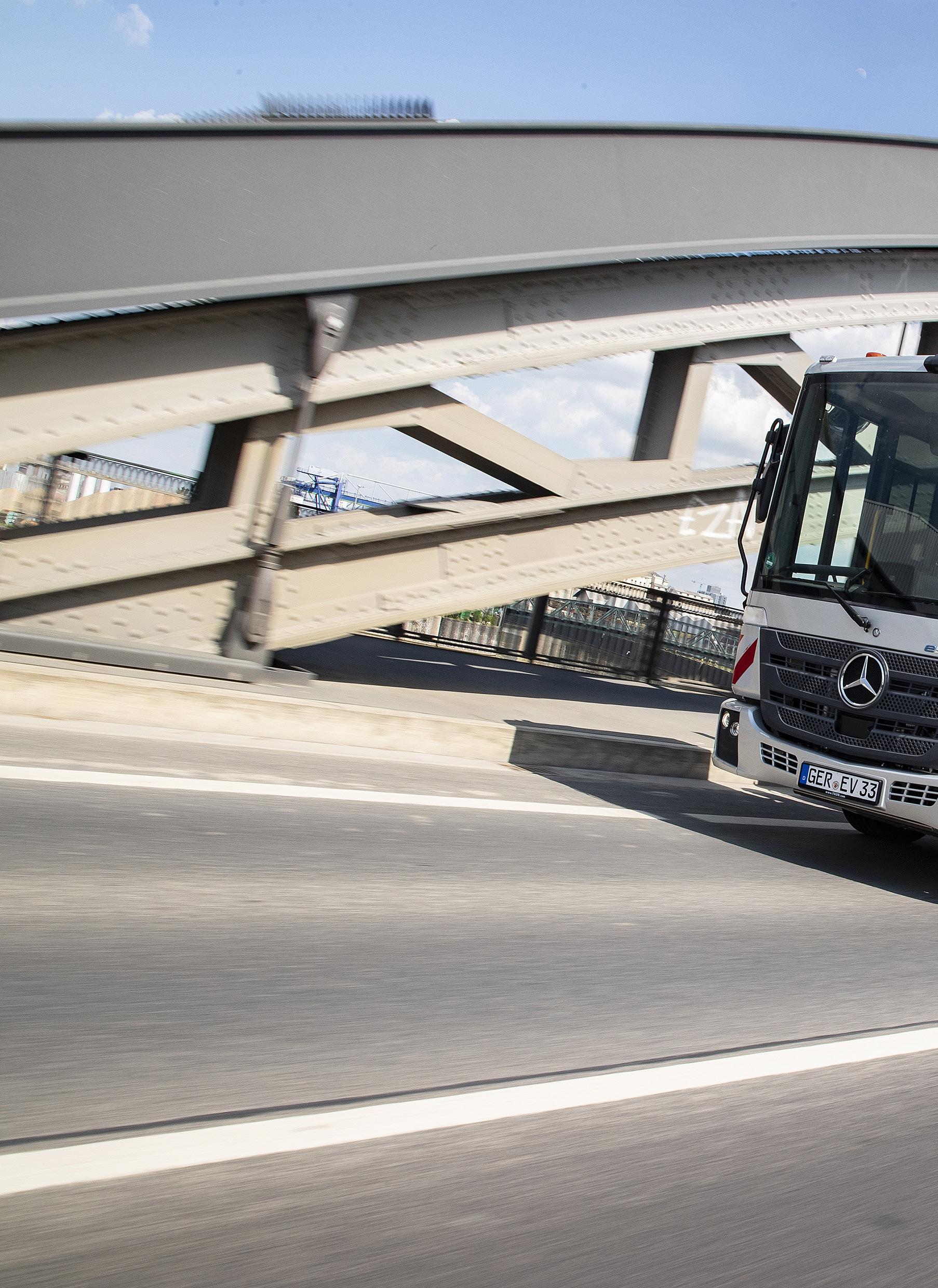
18 destination net zero | issue 2
end
“two liquid-cooled motors give a continuous output of 330kW, rising to a top end performance of 400kW”
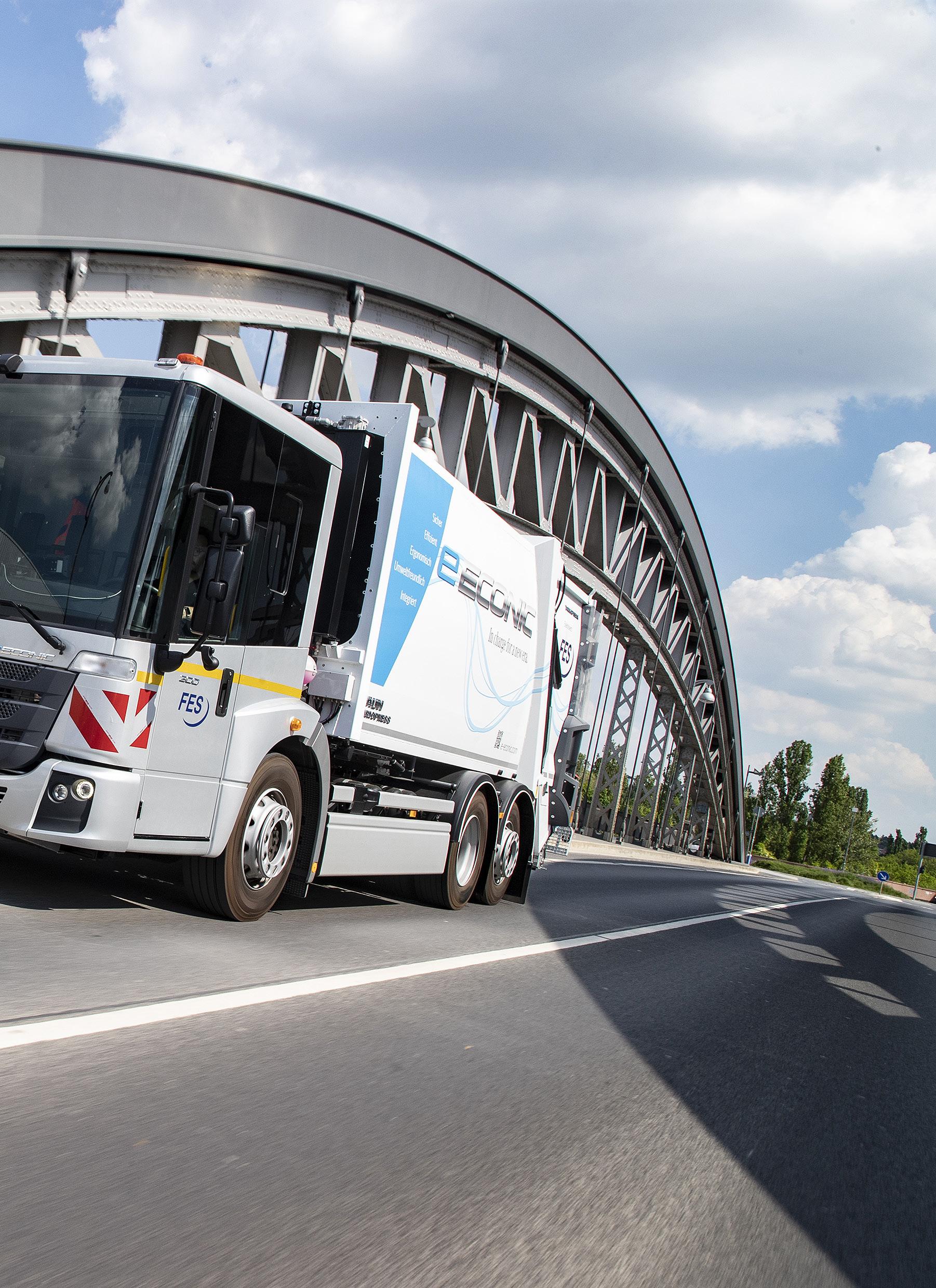
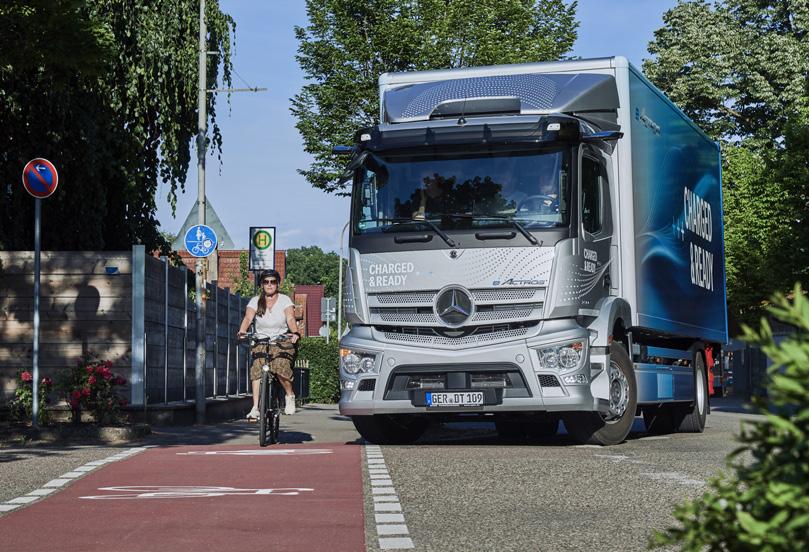
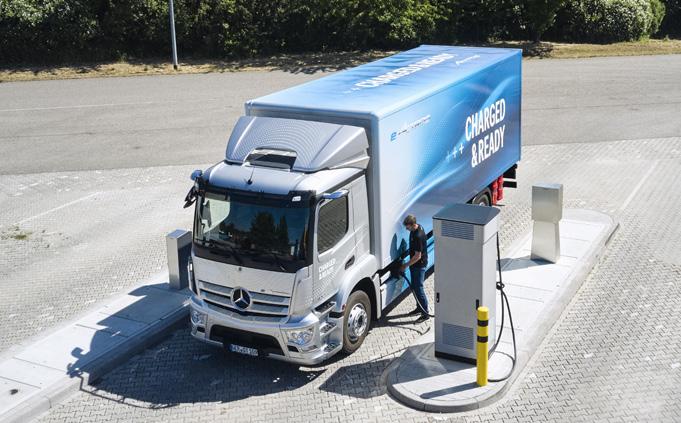
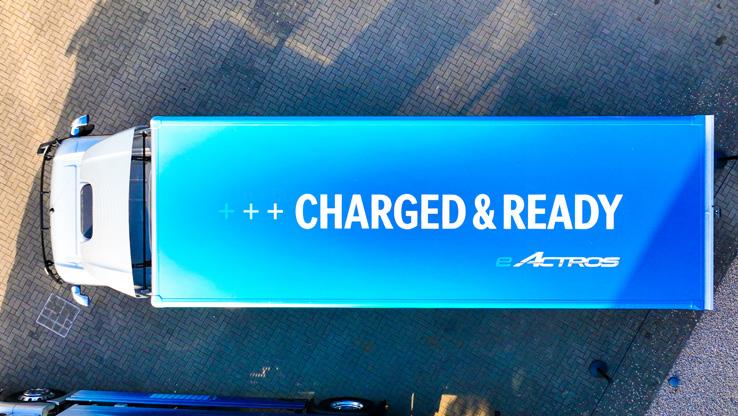
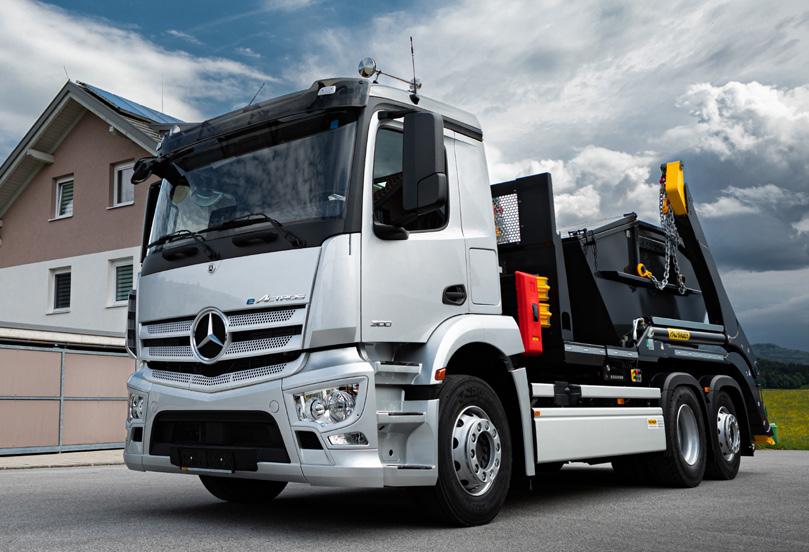
issue 2 | destination net zero 19 • Skip gear is powered by traction battery • Range is up to 400km
Small Electric Van Round-up


There has been an enormous boom in the number of small electric vehicles being brought to market in the last 12 months but with the technology moving so quickly and buyers wary of their capabilities there is a wide variety of vans in all manner of shapes and sizes to choose from. We review the options from the cheap and cheerful to premium passenger car-based electric vans and hybrids.
Renault Kangoo E-Tech / MercedesBenz eCitan / Nissan
Townstar Electric
The Renault Kangoo is the oldest and most established name in the small electric van field but the latest version shares only its name with the trailblazer model launched in 2012. The latest van returns with a new E-Tech name to reflect the rest of the electrified Renault models and is accompanied by two cousins with versions from Mercedes-Benz and Nissan. All three models offer a different take on the electric city van, with Mercedes opting for a more upmarket interior and more standard safety systems than the Renault, while Nissan plays off its warranty support and value. All three vans, however, use the same 90kW motor paired to a 45kWh battery pack. Range for the vans is 186 miles, while charging can be carried out using an 80kW supply to add more than 100 miles in less than 30 minutes. Slower 22kW charging is also possible as well as a from domestic single-phase 7kW supply though a wallbox which is said to take six hours. The van is available in two wheelbase lengths with the standard van having a 3.9m3 load volume and the long-wheelbase model up to 4.9m3 of capacity. Payload for regular vans will be up to 600kg but thanks to a higher gross vehicle weight the larger models can transport up to 800kg. They also have a 1,500kg towing capacity. Prices start at around £30,000 for the Nissan version.
20 destination net zero | issue 2
“Range for the vans is 186 miles, while charging can be carried out using an 80kW supply to add more than 100 miles in less than 30 minutes. ”
Citroen e-Berlingo / Peugeot e-Partner / Toyota Proace City / Vauxhall Combo-e


The city vans of Citroen, Peugeot, Toyota and Vauxhall have taken the successful underpinnings of the medium-sized electric van from Stellantis and applied then to the compact packaging of their small van range. Built in France for Stellantis siblings Citroen, Peugeot and Vauxhall and also produced on behalf of Toyota, the van leads the small van sector with a 171 mile range from a 50kWh battery pack and is paired to a 100kW (136bhp) motor producing 260Nm of torque. Despite being small, the vans offer a load capacity of 4.4m3 thanks to a load-through bulkhead with folding passenger seat which extends the 3.3m3 and 3.9m3 capacities of the standard and long wheelbase vans. The four vans can also have a very respectable payload of up to 800kg and have a towing capacity of 750kg. For added versatility, they can be specified with a E-Power take off system to power conversions such as fridge units. Charging can be carried out using 100kW charger, taking the battery from zero to 80% in 30 minutes. The van’s comfortable cabin is focused around the driver with an angled 8in infotainment and navigation touchscreen, and includes several premium features like wireless phone charging and a Surround Rear View system giving a 360-degree view around the van. In total there are 18 driver-assistance systems designed to make the van safer for both drivers and other road users. Prices start from around £27,000 depending on the brand.
cont.

issue 2 | destination net zero 21
DFSK EC35

Chinese-made DFSK vans have made a comeback in the UK through importer Innovation Automotive with the quirky midi-van offering a cheap entrylevel price to electric van ownership. Starting at £20,999 the DFSK EC35 looks like a typical Japanese-style microvan with high sides and a narrow width of just 1680mm. Its unusual proportions don’t mean it is lacking in space with a maximum loadspace volume of 4.8m3 and an equally impressive payload capacity of 1,015kg thanks to its lightweight 1585kg kerbweight. It has a hinged rear tailgate and gets twin sliding doors as standard. Power comes from a 60kW (80bhp) motor paired to a 39kWh lithium-ion battery with 200Nm of torque. While options are few and far between, one thing you can choose is the maximum speed limit of the van, with a 50mph limited model or a faster 62mph van. Depending on which version you choose will dictate how far you might be able to travel with a claimed range of 101 miles or 166 miles, according to the WLTP testing cycle, for the slow and fast versions respectively. The DFSK EC35 is able to be charged at a maximum rate of 40kW with the battery level going from zero to 80% in around 60 minutes. Topping up the battery to 100% on a 40kW charger will take 90 minutes, while charging from a 7kW wall box will take six hours.

Maxus e Deliver 3
Arguably the first electric van to be launched that was conceived purely as an EV, the Maxus e Deliver 3 was nevertheless a big departure for Chinese-owned Maxus whose line-up had previously consisted of both diesel and electric models.
Designed from the ground-up as a pure electric van with a heavy focus on its aerodynamic performance, the e Deliver 3 has a claimed range of up to 213 miles for its WLTP city range and 151 miles for the combined WLTP standard. It has the option of two battery packs with either 35kWh or 50kWh cells and is paired to a 90KW motor producing 255Nm of torque.

It can carry up to 945kg of payload and despite only being available in a short wheelbase has a volume of 4.8m3 Charging times using a DC rapid charger will see the battery level go from 5% to 80% in just 45 minutes, while a threephase 11kW AC charge will take around five hours.

Standard features include air conditioning, built-in Sat Nav, smartphone mirroring with Apple CarPlay and Android Auto compatibility as well as USB and Bluetooth connectivity. Its most appealing feature, however, is its price with models starting from just £27,000 with a government grant.
Operators can also have the e Deliver 3 as a chassis cab and can get real-time telematic data through a partnership with Geotab.
22 destination net zero | issue 2
“The quirky midi-van offering a cheap entry-level price to electric van ownership”
Toyota Corolla Commercial Hybrid

It’s been years since the Vauxhall Astravan disappeared from sale but the Toyota Corolla Commercial Hybrid van more than makes up for the shortfall. Based on the Corolla Touring Sports estate passenger car, it is a full self-charging hybrid electric van. It looks, feels and drives like a car, but has a healthy 1.3m3 loadspace area in place of the rear seats.
Power comes from a 1.8-litre petrol engine and is paired to a 53kW electric motor, together the petrol hybrid Corolla Commercial produces up to 90kW (120bhp) and 142Nm of torque.


It’s the only engine choice and there’s also only one trim level but the interior is far from your typically commercial vehicle. The Corolla Commercial gets a decent level of equipment including heated seats, dual-zone climate control and a reversing camera. There’s also LED headlights as standard. When it comes to safety, the Corolla Commercial Hybrid isn’t short on features. It gets adaptive cruise control, high beam assist headlights and lane keep assist as standard. Lane Trace Assist also helps to keep the van in the centre of the lane even while turning slight bends, and there’s Road Sign Assist to remind you of the speed limits with an audible or visual warning. In the rear, the loadspace floor gets a rubber lining and there is a full-height steel bulkhead to protect the front seat occupants. There’s also an interior light and a 12v power outlet but the important figure is the 425kg payload and 750kg towing capacity. Prices start from £22,149, excluding VAT.
Volkswagen ID Buzz Cargo


The Volkswagen ID Buzz Cargo is a brand-new electric van that takes its inspiration from the classic Volkswagen Type 2 campervan. It sits between the Volkswagen Caddy and the Volkswagen Transporter T6.1 in the Volkswagen range in terms of its size and is built on Volkswagen’s shared MEB electric drivetrain platform. Despite being a van, with a load volume of up to 3.9m3 and 650kg payload, the ID Buzz Cargo actually borrows many of its features from Volkswagen’s passenger car models including the Volkswagen ID.3 and the Volkswagen ID.4 passenger cars. A 150kW motor powers the van, producing 310Nm of torque in the process. There is currently just one battery option, a 82kWh unit providing a claimed range of up to 256 miles. Charging from 5% to 80% can be done in less than 30 minutes thanks to a maximum charge rate of up to 170kW on a DC charger.
For those needing more payload, a smaller battery pack size is likely to be added to the line-up reducing range but pushing capacity to around 750kg. Two trim levels are available, Commerce and Commerce Plus, with entry-level models receiving a high level of equipment including LED headlight, a heated driver’s seat, front and rear parking sensors, 10” touchscreen and wireless App-Connect for Apple CarPlay and Android Auto. Commerce Plus models get Adaptive Cruise Control, keyless entry, Park Assist Plus with memory function which allows you to effectively record difficult parking manoeuvres to be automatically repeated. There are also safety features including driver assistance systems like Travel Assist, Lane Assist, Side Assist and Emergency Assist. Prices start from £38,125 and includes three services and an MoT.
issue 2 | destination net zero 23
The digital call to arms forcommercial fleets
Beverley Wise, Webfleet Regional Director UK & Ireland for Bridgestone Mobility Solutions, considers our digital journey to a sustainable transport future.
With the impending ban on the sale of new petrol and diesel vans honing into sharp focus – and a fossil fuel HGV ban hot on its heels – the decarbonisation of transport is starting to gather momentum.
Electric van registrations are on the rise, with take-up for the first half of 2022 increasing by 60 per cent on the same period last year, according to latest figures from the Society of Motor Manufacturers and Traders (SMMT).
Despite this positive trajectory, however, we are only at the start of the journey.
E-LCVs represent just one in every 13 new UK van registrations and only 313 electric HGVs are currently in operation. Ninety-nine per cent of trucks are still registered as running on diesel.
THE DATA SOLUTION TO A GREENER FUTURE
Digital transformation is a prerequisite to accelerating our decarbonisation journey.
For conventional fleets, advanced fleet management solutions, such as Webfleet, can combining a wealth of actionable, reporting intelligence – everything from vehicle location, routing, scheduling and driver behaviour scores to mpg and idling time, maintenance and fuel card information – to reduce fuel consumption and monitor trends that impact carbon efficiency.
Dedicated EV management tools, meanwhile, can offer insights to ease the electric transition and support the on-going operation of electric fleets – minimising cost and optimising performance.

Information on real time battery levels, remaining driving ranges and energy usage can be accessed, alongside insights into charging processes and vehicle charge levels.
SEIZE THE DAY
Latest research from Keener to be greener report by Bridgestone Mobility Solutions has revealed that only 53 per cent of commercial fleets currently have a ‘robust’ strategy for net zero transport, and more than a third (34 per cent) believe their incumbent technologies are insufficient to manage the environmental impact of their vehicles.
While some fleet and transport managers are under pressure from board level execs to develop electrification strategies, it is clear others are struggling to champion the cause and make their voices heard.
Despite more than half (57 per cent) acknowledging that the reputational benefits of having a sustainable fleet would lead to increased business for their company, the study found that more than half (56 per cent) believe decarbonisation risks being held back by competing business interests. Sixty-on per cent say a cultural shift is needed within their company for it to be embraced by all business stakeholders.
Establishing a strong business case that brings all influential stakeholders on board – from sustainability and utility managers to heads of finance, HR, procurement and marcomms – can be crucial for fleets looking to make the electric transition.
Calculating projected Total Cost of Ownership (TCO) savings, using telematics data to compare conventional internal combustion fleet running costs with EV alternatives, is a persuasive starting point. Indeed, the savings already being achieved by progressive fleets are unequivocal.
Digital fleet management solutions can ultimately be viewed as sustainability game-changers – the actionable data they impart not only enable fleets to deliver on our net zero ambitions, but they are proving the decisive catalyst for the green transport revolution.
24 destination net zero | summer 24
Are you ready to lower emissions and succeed with a transformative EV fleet strategy?
Are you ready to lower emissions and succeed with a transformative EV fleet strategy?
Are you ready to lower emissions and succeed with a transformative EV fleet strategy?
Your ideal partner in decarbonising your business fleet
Your ideal partner in decarbonising your business fleet
Your ideal partner in decarbonising your business fleet
Webfleet
forefront of EV adoption, giving you the right tools

of
adoption, giving you the right tools
your electric vehicles. Our comprehensive platform is
vehicles. Our comprehensive platform is
evolving
help you effectively oversee your EV fleet operation for
help you effectively oversee your EV fleet operation for
long term.
can continue confidently towards a goal of
Webfleet, you can continue confidently towards a goal of net-zero emissions.
Webfleet Solutions is at the forefront of EV adoption, giving you the right tools to get the full value from your electric vehicles. Our comprehensive platform is continuously evolving to help you effectively oversee your EV fleet operation for the long term. With Webfleet, you can continue confidently towards a goal of net-zero emissions.
Region - All 003 - Express VEHICLES (4/21) 004 – Service 006 – Transport 005 – Express Search Available ELECTRICAL EXPRESS Battery level 33 % Range 120 km Remaining charging time 2 h 45 min 09:52, 78 Stagg Hill, Barnet, EN4 0PX, UK 29/02, 10:16, 81 Boundary Road, Woking, GU21 09:53, Manchester (Salford), M3 6, UK Let’s drive business. Further. webfleet.com
Webfleet Solutions is at the forefront
EV
to get the full value from your electric
continuously evolving to
the long term. With Webfleet, you
net-zero emissions. Region - All 003 - Express VEHICLES (4/21) 004 – Service 006 – Transport 005 – Express Search Available ELECTRICAL EXPRESS Battery level 33 % Range 120 km Remaining charging time 2 h 45 min 09:52, 78 Stagg Hill, Barnet, EN4 0PX, UK 29/02, 10:16, 81 Boundary Road, Woking, GU21 09:53, Manchester (Salford), M3 6, UK Let’s drive business. Further. webfleet.com
is at the
to get the full value from
continuously
to
the
With
Region - All 003 - Express VEHICLES (4/21) 004 – Service 006 – Transport 005 – Express Search Available ELECTRICAL EXPRESS Battery level 33 % Range 120 km Remaining charging time 2 h 45 min 09:52, 78 Stagg Hill, Barnet, EN4 0PX, UK 29/02, 10:16, 81 Boundary Road, Woking, GU21 09:53, Manchester (Salford), M3 6, UK Let’s drive business. Further. webfleet.com
Steve Bridge leads from the front. It brings results.
Asmanaging director of eStar Steve Bridge has just seen the Mercedes-Benz van and truck dealership ranked within the top 50 Inspiring Workplaces in the EMEA (Europe, Middle East and Africa) region. It was placed at number 48 by the Inspiring Workplaces Group’s independent expert panel in the first-ever EMEA list it has compiled.
The panel measures six key elements that it believes are fundamental to the creation of an inspiring workplace: culture and purpose, leadership, wellbeing, inclusion and diversity, communication and employee experience.
Says Bridge: “To win this ranking within 18 months of establishing eStar is an exceptional achievement, and a fantastic recognition of all the hard work and team work that we have achieved together.”
Owned by industry leaders Sid Sadique and Ali Sharifi, eStar employs 330 people at depots in Liverpool, Trafford Park in Manchester, Stoke-on-Trent, Deeside and Warrington in Cheshire.

Bridge became eStar Truck & Van’s MD in February 2021 after over 20 years working for Mercedes in the UK, latterly as managing director of Mercedes-Benz Vans. “I’m still sitting at the same table, but in a different seat,” he smiles.
The dealership was created in September 2020 after Sadique stepped in to acquire most of the assets of previous dealer Roanza Truck and Van after it went into administration.
A Mercedes customer for many years, Sadique set up Riverside Truck Rental in 2006 and zero-emission truck specialist Electra Commercial Vehicles in 2017. He went on to team up with brothers Steve and Paul Rooney in the acquisition of Kent Mercedes dealership Sparshatt Truck & Van in 2018.
“So far as eStar is concerned we spent the first year stabilising things in a market area that was in some disarray,” says Bridge. “In the second year we’re growing a culture and defining what our values are.”
They are clearly set out in the Inspiring Workplaces accolade, and it is undoubtedly helping enormously with staff retention.
“There’s a legend that technicians are hard to recruit, and hard to hang onto, but that’s not really the case,” Bridge observes. “If you give them the right working conditions and you make it clear that you value themthey do the hardest job in the building after all - then why would they want to move anywhere else?”
Running a large commercial vehicle dealership at a time of escalating inflation, rocketing fuel prices and in the wake of the coronavirus pandemic is not for the faint-hearted or inexperienced says Bridge, a 37-year motor industry veteran who has worked through three recessions. “Despite all the challenges we faced we stayed open throughout the pandemic, even though at one stage we had 29 employees off at one site with positive Covid-19 tests,” he says.
Now he and his colleagues are having to explain to customers that the prices of the vans and trucks they need are rising sharply. What is more, they may have to wait until well into 2023 before their vehicles arrive depending on what they have ordered.
“Having to have these conversations is certainly character-building,” he says. “What I’m advising them to do is get their name on the list, and I will do the best I can to accelerate delivery.”
The company will supply several hundred vans and trucks this year, and could supply considerably more if they were available.
Testing times are not preventing eStar from investing. It is pumping almost

26 destination net zero | issue 2
“We’re putting in a dozen charging points at Knowsley, from 22kW to 110kW, and my aim is to install 60 across the two sites”
Steve Bridge, managing director, eStar Truck & Van
- 2022
£4m into two new sites on the Alchemy Business Park in Knowsley, Liverpool as well as improving its Trafford Park branch.
Completed in December 2021, the Knowsley depots house the teams previously based in eStar Liverpool (Wavertree) and eStar Warrington. (Risley). Not far from a huge Amazon distribution centre, Trafford Park’s new refurb was finished September 2021.
One of the new Knowsley outlets (45,586sq ft) is dedicated to trucks, and will be eStar’s head office. The other (22,946sq ft) will concentrate on vans.

Why split vans and trucks?
“I think there will be more of a separation between the two over the next five years, and I want us to follow the same approach at Trafford Park,” Bridge replies. “If you are a van buyer then your retail expectations are increasingly becoming the same as those of a car buyer.”
In another development, last year saw the Deeside operation gain the EvoBus aftersales franchise. This means it is authorised to service and repair MercedesBenz and Setra coaches, buses and minibuses.

• One of the new Knowsley outlets (45,586sq ft) is dedicated to trucks, and is eStar’s head office.
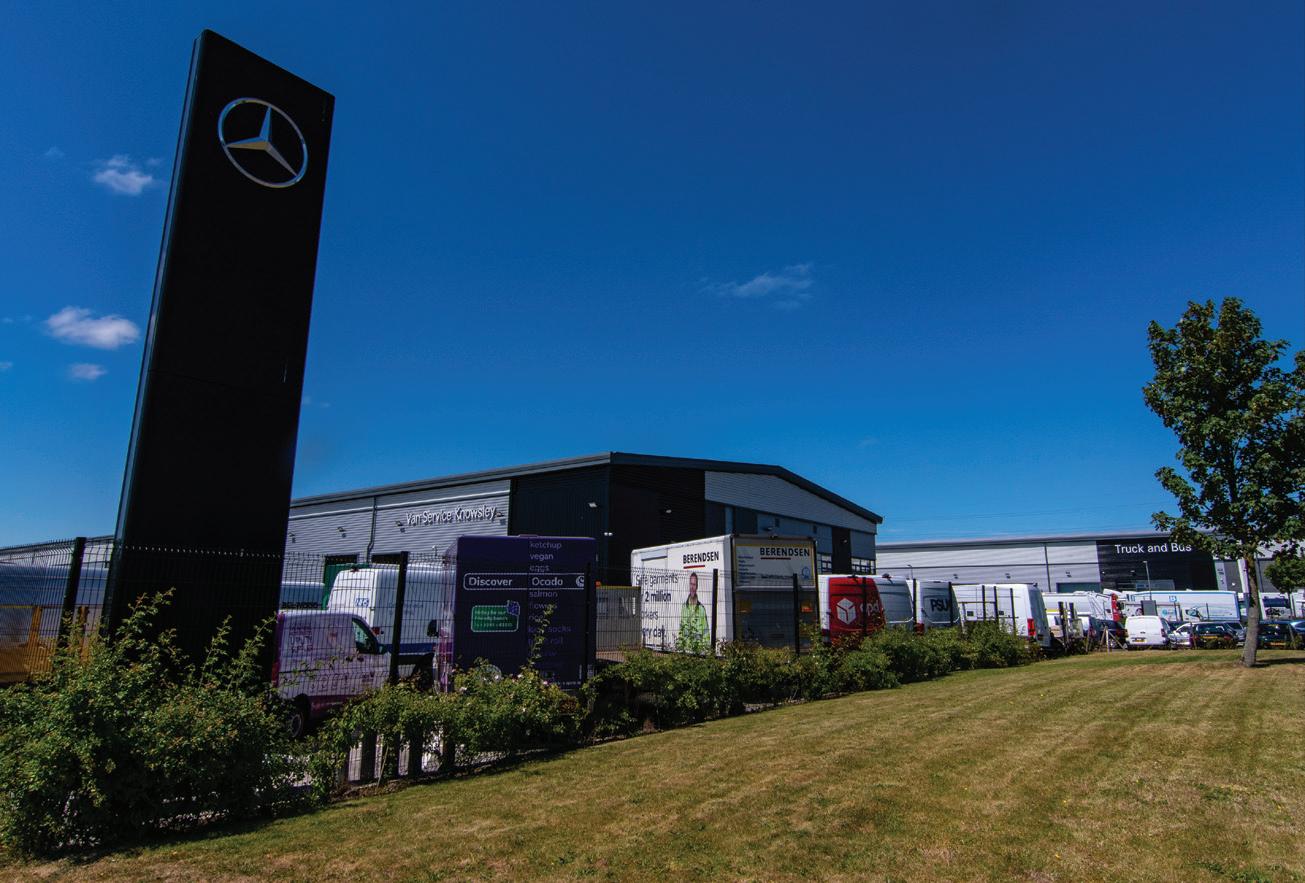
• The other (22,946sq ft) concentrates on vans.

issue 2 | destination net zero 27
cont.
• eStar Van Service, Knowsley
• Steve Bridge, Managing Director
“North Wales is a key route for many passenger transport operators,” Bridge points out. “Knowing they can receive the support they need from eStar means they can continue to focus on their business and keep their customers moving.”

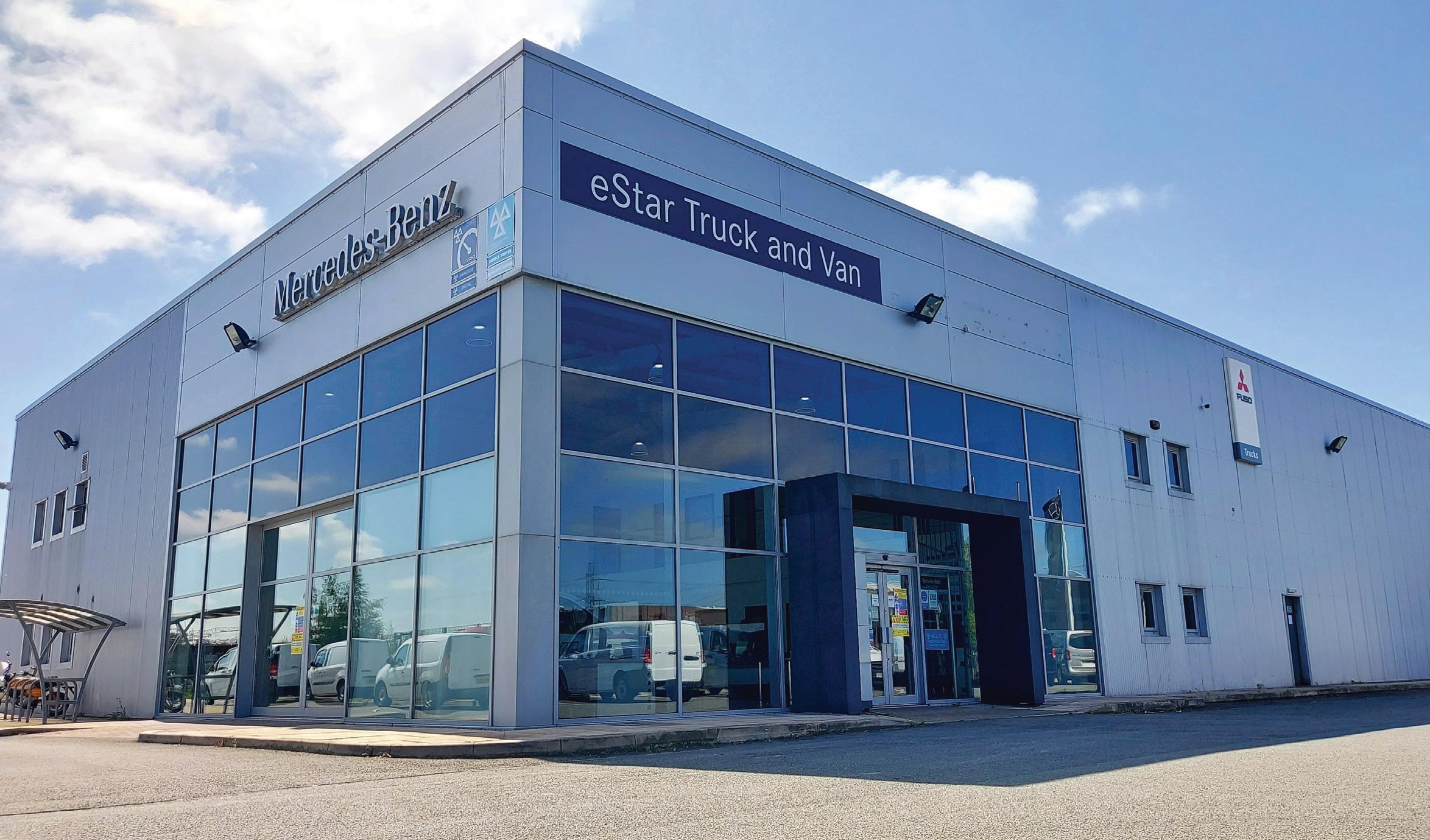
Perhaps the biggest longer-term challenge eStar and other dealerships now face is the gradual transition to battery-electric and hydrogen fuel cell power trains. It’s a challenge Bridge is embracing.
“We’ve placed a dozen charging points at Knowsley, from 22kW to 110kW, and my
aim is to install 60 across the two sites,” says Bridge. “What’s more, we’ve put the first hydrogen fuel cell refuse truck into service with St Helens Council in conjunction with Faun-Zoeller.”
Based on an Econic, the Faun Bluepower has been developed in collaboration with Daimler Truck.
“Among other things the transition means we have to train sales people to be more consultative, less desperate to sell, and more desperate to listen,” he observes. They need to understand what the customer’s range
and charging requirements will be, and the charging arrangements that will have to be put in place.
“It’s going to be a big change for them,” he observes.
So how would Bridge define his approach to management?
“I like to be visible and lead by example, but without doing peoples jobs for them,” he says. “You’ve got to get your people right first: and fortunately we’ve got an amazing management team at each of our sites.”
Deeside, North Wales
28 destination net zero | issue 2 • eStar
are eStar.

The home of Mercedes Benz commercial vehicles in the North West and North Wales.
are here to support you and your business every step of the way, from expert knowledge in new and used Mercedes-Benz vans and trucks, to extended test drives, connected services, and electric vehicle specialisms.
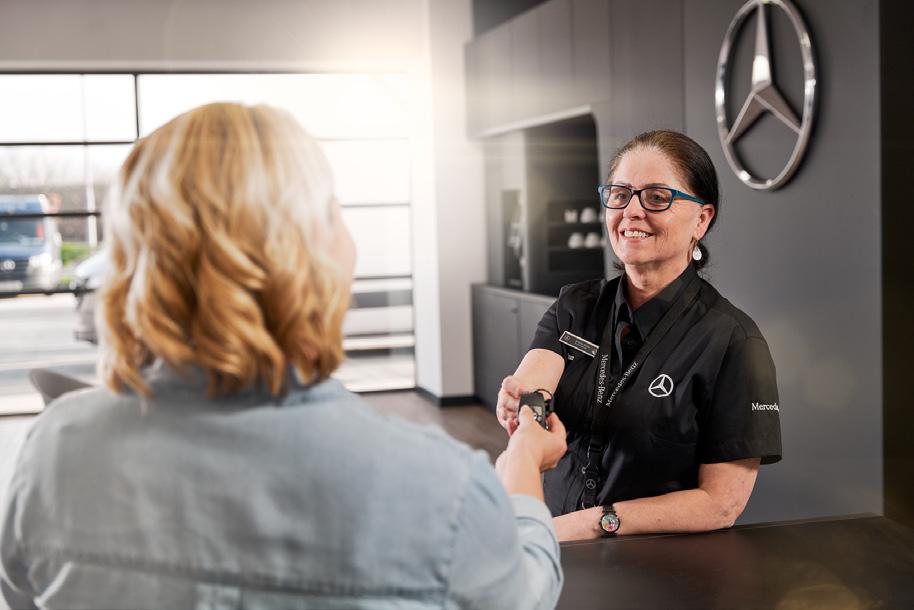
can maintain your vehicle
to keep your business moving, offer round the clock free roadside assistance, and are proud to hold £2m worth of Mercedes Benz GenuineParts in stock to help keep your vehicle on the road, earning it’s keep.
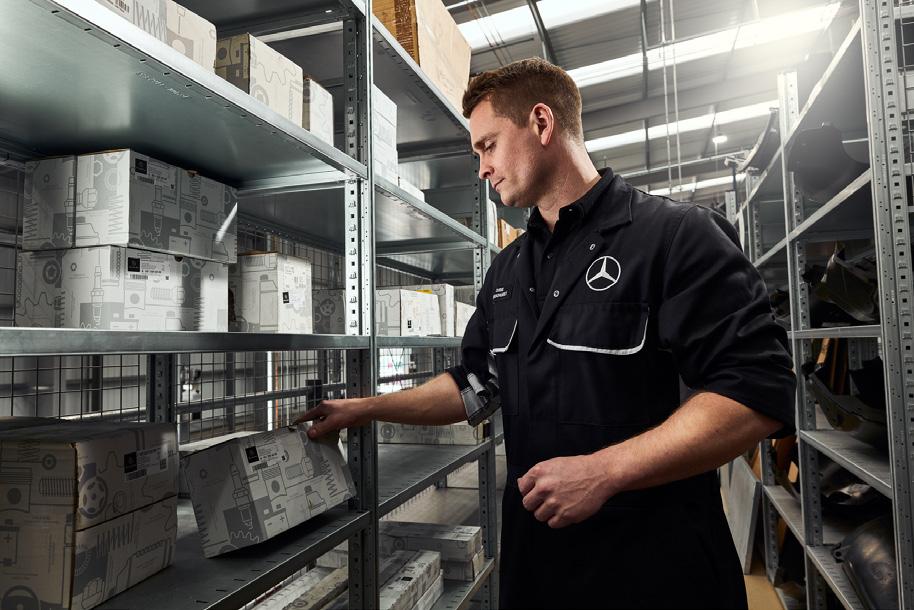
in touch to see how we can support your business today.

We
We
We
24/7
Get
0151 8326760 enquiries@estar.ltd
Game Charger
Words: Matthew Eisenegger

The entire talk around the industry is of electric vehicles. Car and van manufacturers have been actively selling their products for a good few years. Truck manufacturers have had vehicles in development for many years, but trucks provide a whole different set of operating restrictions over that of cars and most certainly vans. Payload and range being the two main considerations. DAF has been very hard at work and recently showcased a number of EV offerings aimed primarily at the urban and inner-city delivery and collection sector. Already entering service is the ‘all new’ LF Electric. Destination Net Zero Magazine managed to get behind the wheel and put it through its EV paces.
By invitation of the DAF marketing team, we were invited along to the Leyland assembly facility where The LF Electric was temporarily based, before heading out on fleet and dealer demonstrations. The route chosen would take us away from the production facility towards Preston and then onto the seaside resort of Lytham and St Annes. From there we would head up the coast to Blackpool. What better way of paying homage to probably the oldest surviving form of EV Transport in Britain, the legendary Blackpool tram? Running up the Golden Mile we then passed the famous pleasure beach as well as all three piers and of course the iconic Blackpool tower. Then we headed back through the back streets of Blackpool, followed by a short burst down the M53, before returning through Preston to the Leyland manufacturing facility.

30 destination net zero | issue 2
“LF Electric could take you up to 175 miles between charges”
The truck industry on a global scale is on the cusp of the biggest change since the introduction of the diesel engine back in the late 1800s.
The look and style of the LF Electric is identical to its diesel-powered sibling. Only an expert can spot the boxed batteries on the side of the frame. Other than that it is identical. The technology is the key to this vehicle. The LF Electric has four battery modules combined into two battery packs on both sides of the chassis. The three temperature-controlled lithium iron phosphate (LFP) batteries provide 2504 kWh regardless of the outside temperature.

Charging Up
When it comes to charging, the LF Electric can be charged by an external direct current (DC) charger, or an alternating current (AC) charger. This means that it is not always necessary to invest directly in expensive (DC) charging equipment. In most cases, low-cost AC charging equipment will suffice to charge the LF electric. To operate the LF Electric in city distribution applications, the CCS charging connector on the LF electric meets the Combo 2 protocol and is positioned on the driver’s side. Either the left-hand side or righthand side of the chassis is possible depending on the driving position. Power delivery comes from a Dana permanent magnet motor, which provides motive power and recovers electrical energy during braking. Efficiency is maximised thanks to the direct drive design and with its brushless construction, the motor is maintenance free. Many vehicles engaged in urban or inner-city work need to provide additional power to ancillary equipment. DAF makes an optional E – PTO available with the LF Electric that delivers 400V AC, making it ideal for the supply of power to refrigerated bodies. The CEE socket is mounted at the rear of the cab and can be directly used to power most refrigeration units. The LF electric has a gross vehicle weight of 19,000 kg, with an unladen weight (with dry freight box and tail-lift) of 9,900 kg giving a payload of just over 9,000kg.

issue 2 | destination net zero 31 cont.
Part 1 Part 2
On the road
Driving the vehicle is very similar to a diesel powered LF. All the driver needs to do is turn the ignition key to bring the system to life, select the driving mode and that’s about it. On the dashboard, the battery charge rate and range will be displayed. As with a traditional automated shift, the rest is down to the driver’s right foot.
Moving away is brisk, in fact very brisk. Joining a dual carriageway, the vehicle accelerates very quickly up to road speeds - a carry-over characteristic from electric cars. That well-known phrase, “range anxiety” also comes to the fore, with the truck driver constantly monitoring the range and planning the route ahead. What is of interest are the behaviour traits of the driver. In fact consideration needs to be given all the time to range and the fact that if you run out of charge you are going to be in a spot of bother, because the vehicle cannot be recovered in a traditional way.
The vehicle really comes into its own when running in an urban environment. As you would expect, it operates in near silence. Diverting away from the coast road we went through the beautiful seaside town of Lytham, with its main street flanked with very nice outdoor eateries, which were busy, as we glided past in virtual silence.
Driver Training
The key to the success of running any type of EV is going to be driver training. Regardless of diesel or electro-mobility, the driver is fundamental to fuel and power usage. Utilising the vehicle’s mass and kinetic energy will play an important part in achieving maximum range and efficiency.
DAF predicts a range of 280km - about 175 miles. There is a level of regenerated power that can be harvested that will help ease the burden of range restrictions, if the driver puts the regeneration to good use.



32 destination net zero | issue 2
The LF Electric, as you would expect, has been engineered to within an inch of its electric life. On the road what surprises is that there are no surprises. Acceleration is brisk, in fact probably too brisk but other than that it drives like a normal truck. Obviously, payload becomes a consideration due to the weight of the batteries. On any urban distribution cycle, a range of 175 miles should easily satisfy a large portion of delivery and last mile scenarios.
The whole process of acquiring an EV is vastly different to that of a diesel truck. It’s more a case of how you adapt business to these new technologies rather than having them just drop straight in and go to work. The actual DAF element of the acquisition process is the easy bit as user confidence already exists in the brand and its dealer network. Rest assured the LF Electric will have been highly engineered.
There are other serious considerations too. There is no truck charging infrastructure on the UK’s highway and motorway

network, meaning the operator will be totally reliant on depot charging. Firstly, the business will need to establish if indeed there is enough electric capacity in the grid to serve the premises. Then comes the process of getting power and charging points into the premises. It may be the location is wrong from the perspective of either not enough electric capacity, or the location is too far from the distribution point, exhausting the vehicle’s range before being able to return to base. Sometimes it could well be a more costeffective option just to simply find a brand-new site with everything ready to go.
From an operational perspective, the main considerations need to be understanding the route and what range requirements are needed. The key to getting the best out of any EV is planning. Obviously, these types of vehicle only suit a certain type of operator and the work that they undertake. In an urban distribution environment they do provide the perfect solution for zero tailpipe emissions.
• The LF Electric promises deliveries on the quiet


issue 2 | destination net zero 33
end
Your Space
Due diligence is the best road to electrification.
Words: Karima Haji, Executive Transformation Director at Scania UK
The burning issue in our segment of the automotive sector is how we decarbonise our industry…and quickly.
This is a pressing challenge facing everyone. At Scania that is where our focus is, to help customers transition from diesel, whether that be to renewable fuels or going electric.
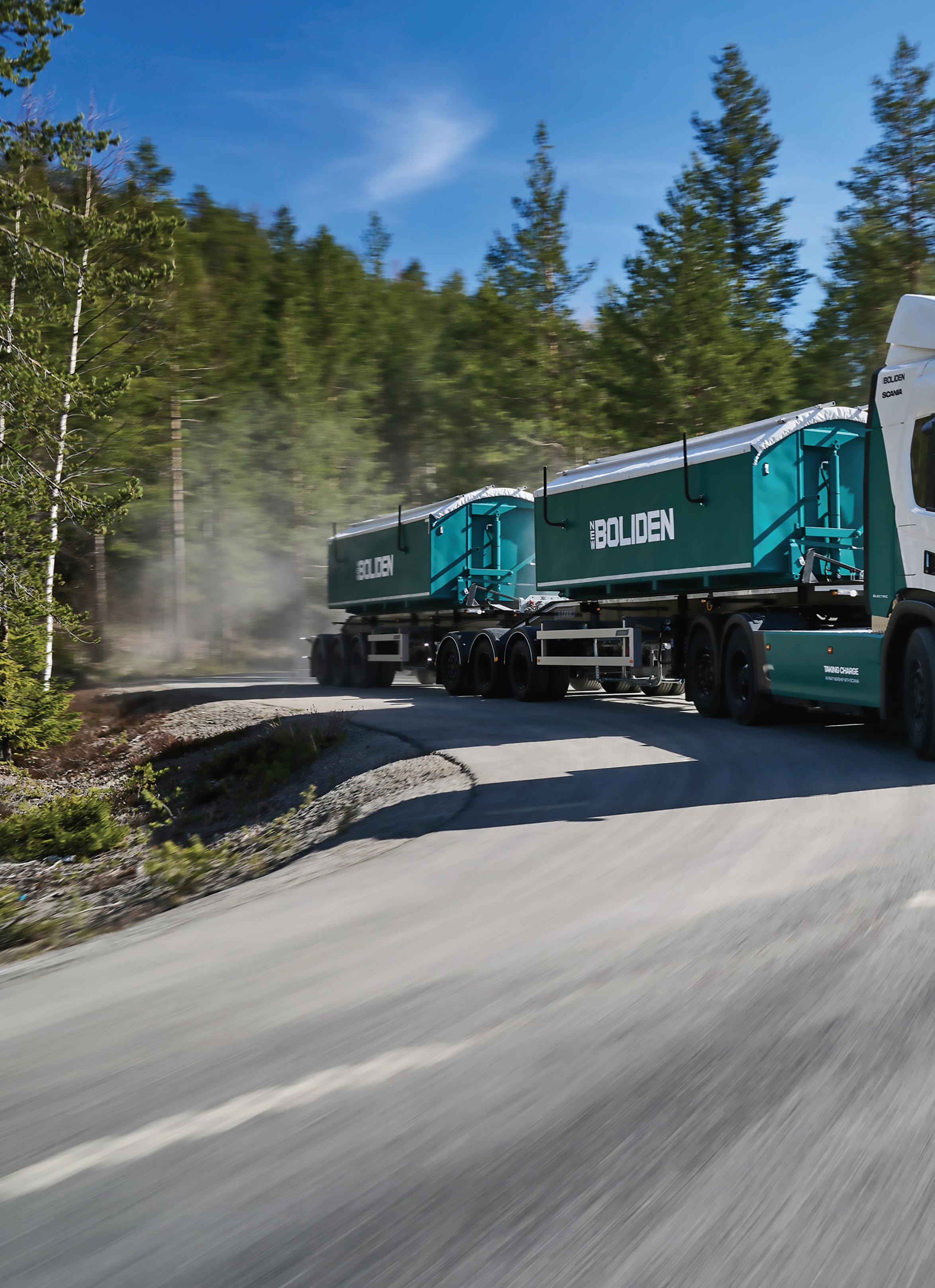
Through our new consultative sales approach, we are positioning ourselves to support anybody making the switch from diesel. Why?
The reality is that the vehicles and technology are here today, especially with EVs. It’s just about deciding when to take this leap of faith and how. But how do you prepare yourself for the transition?
Preparing for change
Firstly - don’t think about the vehicles. Yes, you heard correctly! As strange as that may sound. To prepare for the transition, especially electric, requires a change of mindset. Those who’ve already made the switch to an alternative renewable fuel, such as biogas or HVO, will be used to thinking differently about running their fleet. But for others it will seem alien.
If we take electrification as an example. The quandary filling a lot of peoples’ minds is whether to take the leap or not.
But switching to electric vehicles is not as simple
34 destination net zero | issue 2
“switching to electric vehicles is not as simple as flicking a switch”
Karima Haji

as flicking a switch. The change won’t be instantaneous. It requires a lot of consideration. But it’s important to understand this isn’t something you need to go through by yourself.
You need to focus on your business, your objectives and ambitions. Answering these vital questions will help OEMs better analyse your business and develop a solution that works for you.
Understanding what your prerequisites are upfront will allow us to tailor your solution to meet your needs.
We must aim to think and plan as far in advance as possible. This is key to building solid EV ecosystem foundations that can be extended as your operations grow, and can be adapted as you increase the number of EVs in your fleet.
Once we know your aims and objectives, a thorough analysis of your business is required. We’ll take a closer look at the specifications in your current fleet and create route simulations and range estimations, regardless of what you run.
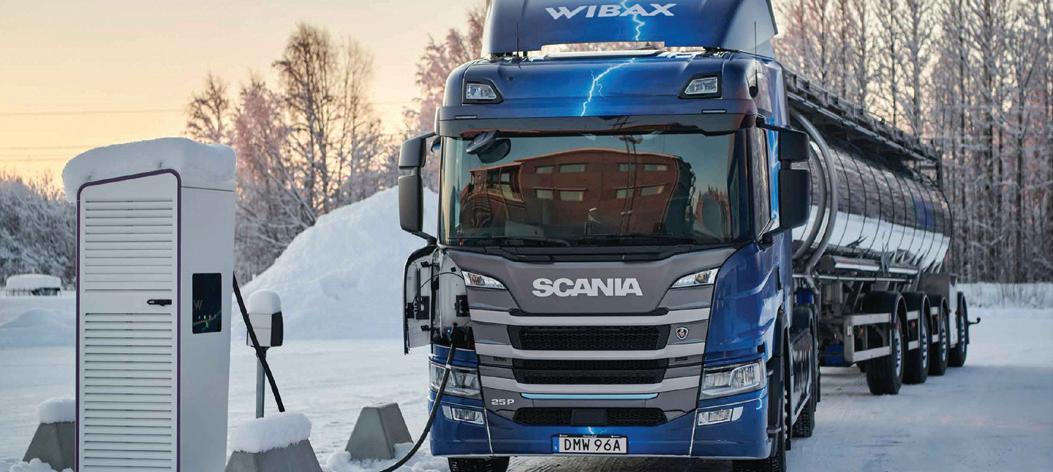
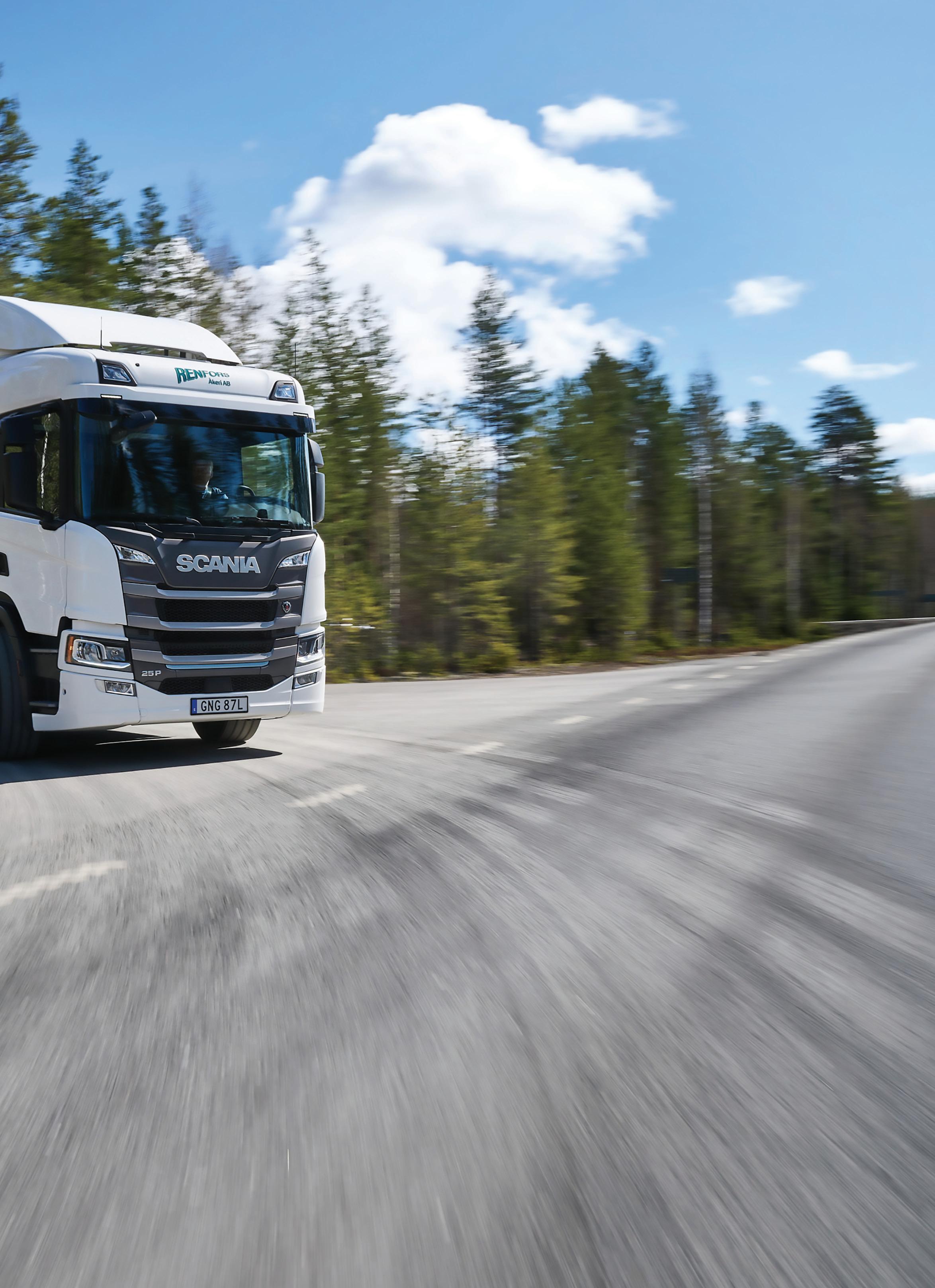
We also analyse energy consumption – taking geography, topography, climate, payloads and operating ranges into consideration. And what the energy needs are from an infrastructure and vehicle perspective.

This includes identifying the charging infrastructure needed and possible strategic locations.
Everything we do is based on your real
issue 2 | destination net zero 35 cont.
• Renewable energy generation •
operations. Providing the best possible data creates the perfect starting point for tailoring a charging solution to support your electrification roadmap.
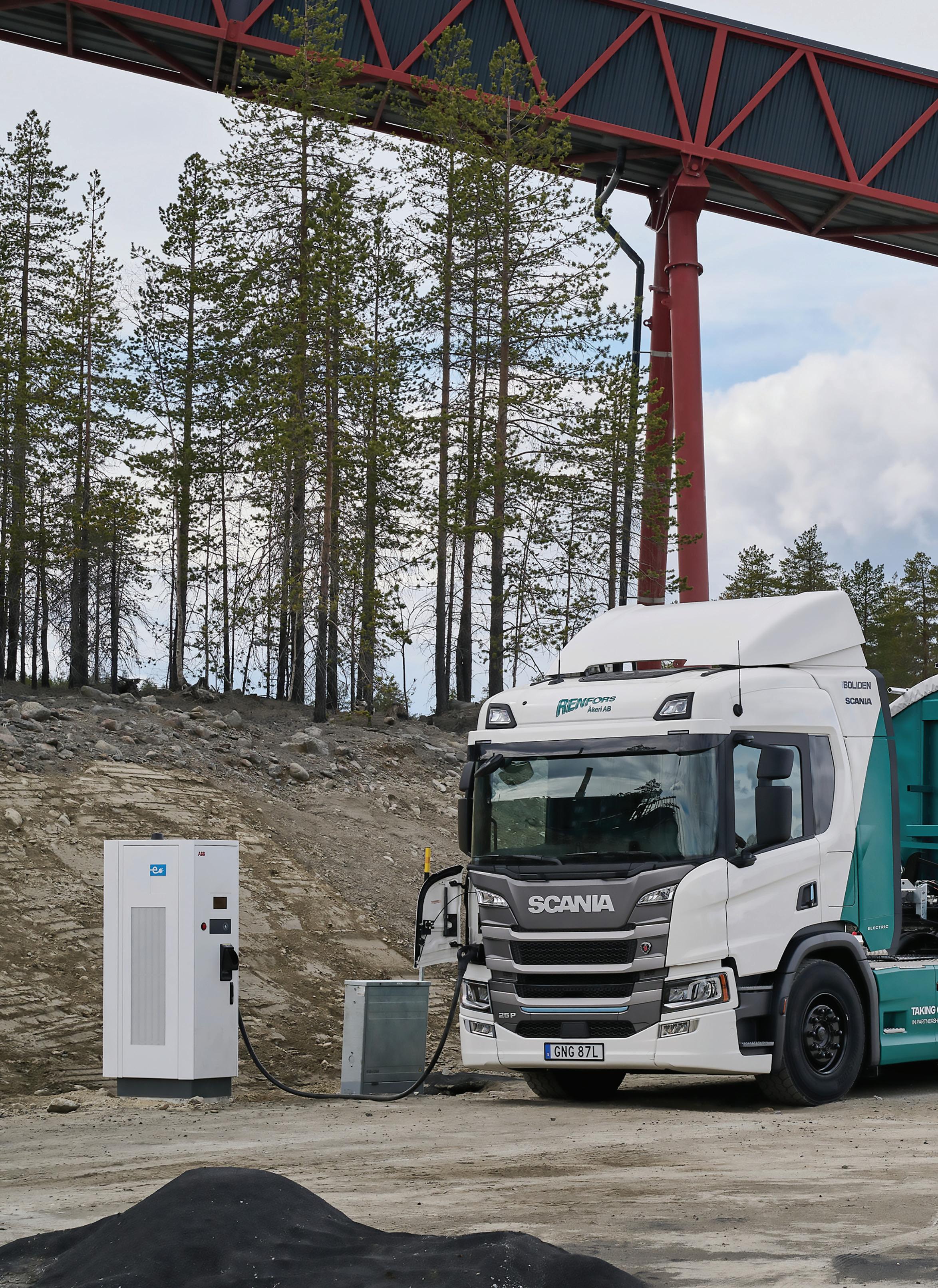
These are all complex decisions that take time – so you need to plan ahead.
Be prepared to invest time, not just money
The process of buying a battery electric vehicle is naturally more involved. This is an emerging technology for our industry, and careful consideration and decision-making will be essential to make it work long-term.
You need to accept time is needed for thorough analysis. Together we need time to build the charging infrastructure and secure the right amount of power at your sites. This can take up to 37 weeks. Or 259 days, 6,216 hours or 372,960 minutes. However, you choose to look at it – it’s still a long period of time. If you then require destination charging, this could add an additional 18 months to your timeline depending on partners you work with, or whether you choose to invest yourself.
So where do you start? Our recommendation is to start small scale with a simple solution to allow yourself and your business time to learn and adjust. Once the analysis has given us the complete picture, we will advise you on the best products and most suitable charging equipment for your operations. Both in terms of what’s needed to electrify your vehicles today, and to prepare scaling up your fleet for the future.
Our complete solution will cover you for the vehicles, charging and the repair and maintenance support to maintain maximum uptime.
We can tailor this with the right digital solutions using Charging Management System software to
36 destination net zero | issue 2
“This will be Sweden’s largest public truck charging station
ensure productivity and uptime as well reducing operating costs. And of course, we continue to offer financing to ensure you can manage costs.
Transitional challenges can bring revenue opportunities
At Scania, we are taking this transition to a non-combustion powertrain seriously. So much so, that we are pushing the boundaries to test the feasibility of battery electric technology in extreme scenarios.
Our Pilot Partners series has seen battery electric prototypes trialled in mines and on logging trails. In one customer’s case, they even found an additional revenue opportunity.
Falkenklev Logistik approached Scania to deliver a complete e-mobility solution. This included five battery electric trucks and a 1.6 MW charging solution as part of their plan for a 22-vehicle public charging station. The key was to future proof the site to extend it up to 40 vehicles in the future.


They wanted to charge their vehicles during their down time and offer charging for public use as an additional revenue source, when the infrastructure would otherwise be idle.
It was through thorough analysis that it was possible for Falkenklev to spot an opportunity to maximise their investment.
Alongside this they have installed a 1.5-hectare solar park with 2 MW battery storage to ensure they have renewable energy aligned to their sustainability goals. When it’s completed this will be Sweden’s largest public truck charging station.
While transitioning from diesel comes with challenges, there are also lots of opportunities too. At Scania we will help you embrace the change.
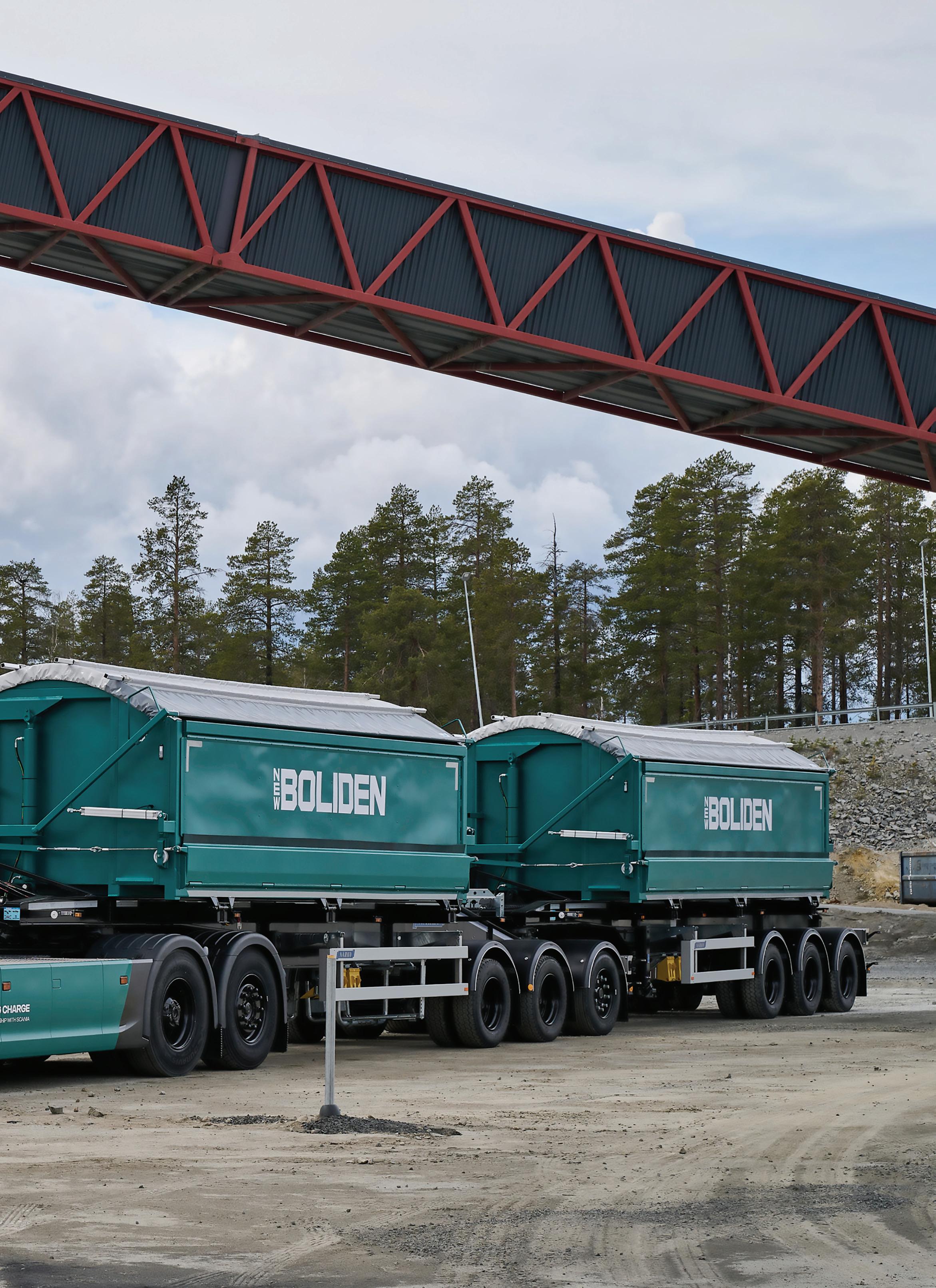
issue 2 | destination net zero 37
end • Scania Electrifiction timetable
EV Charging on the road and at home – made simple
With the UK Government aiming to become Net-Zero by 2050, the way businesses operate will need to change and switch to a greener alternative to help lower the UK’s emission rate. Add in the rising cost of petrol & diesel; now’s the perfect time to consider switching to an electric vehicle.
Our Chargepass® is the perfect solution for drivers on the go.
Product features:
· Access to 7,500 +charging-ports across the UK with a single RFID card.

Introducing you to Chargepass®
Rachel Pearson, Fleetmaxx Solutions, Business Development Manager, says, “With our Chargepass®, we provide your driver with a single RFID card which gives access to thousands of public charging points across the UK. Drivers tap the charge point to activate the charge when they’re on the road. Our driver’s app shows the location of their nearest charging ports. With our Chargepass® & Business Homecharge® solution, there will be no driver payments or expenses; we gather the charging activity through our portal. Your charging appears on a single monthly invoice to the fleet manager or owner.”
· Drivers “tap” to activate a charge on the road.
· No driver payments, mileage to submit

· Personal vs business split
· No driver’ resistance to change,’ as they will never be out of pocket (HMRC guidelines allow a maximum of only four pence per kilowatt)
· No ‘range anxiety’ as no other payment solution offers more locations to recharge than Chargepass®
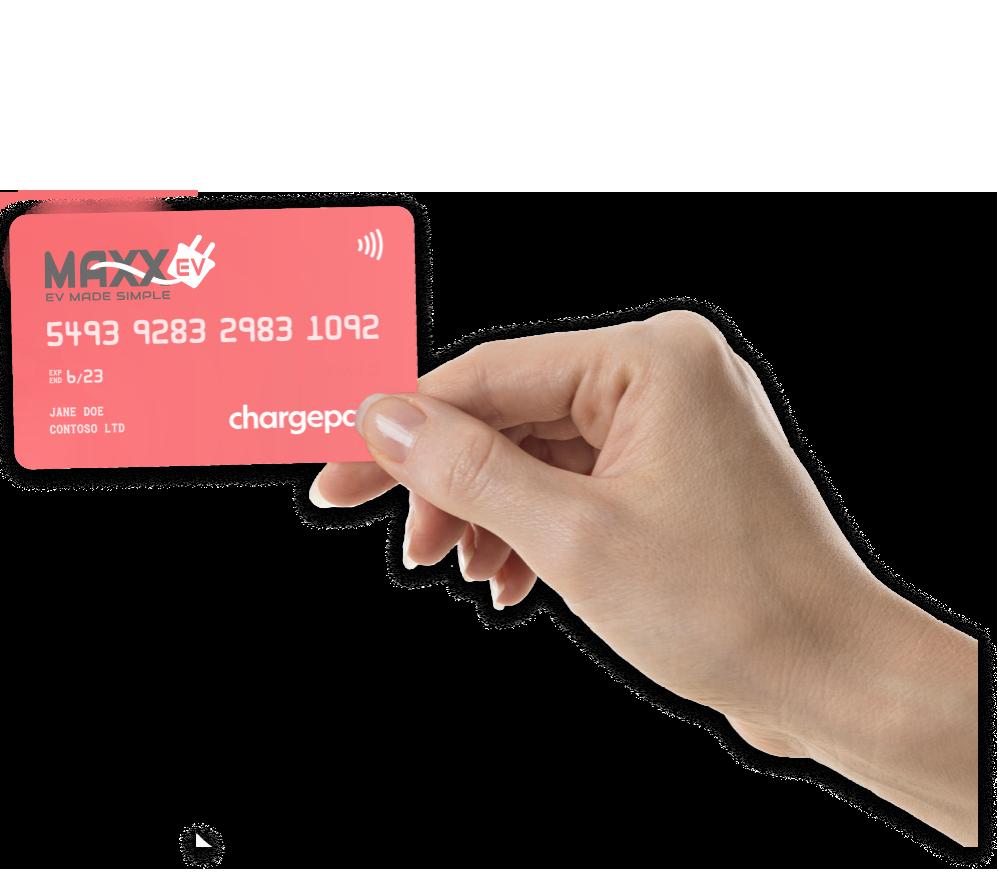
“Not interested in fully switching your fleet to electric? Our MaxxEV solution combines your fuelling and charging costs (petrol, diesel, and charging) into one easily managed monthly invoice. This will save you hours of tedious admin work to allow you to focus on more important things,” added Rachel.
Rachel and the team at Fleetmaxx are so confident in Chargepass®, we’re offering 3 months FREE, so you can try before you buy! Visit our website – www.evfleet.solutions Email – rachel.pearson@fleetmaxxsolutions.co.uk Telephone – 01227 936 853
EV PUBLIC CHARGING MADE SIMPLE!
1 Use the app to nd your nearest charge point, UK’s largest network.
2 Connect your vehicle to the charging point using the charging cable.
3 Tap your Chargepass® on the charger’s card reader to begin charging.
4 To end charging tap your Chargepass® again and unplug the cable - SIMPLE!
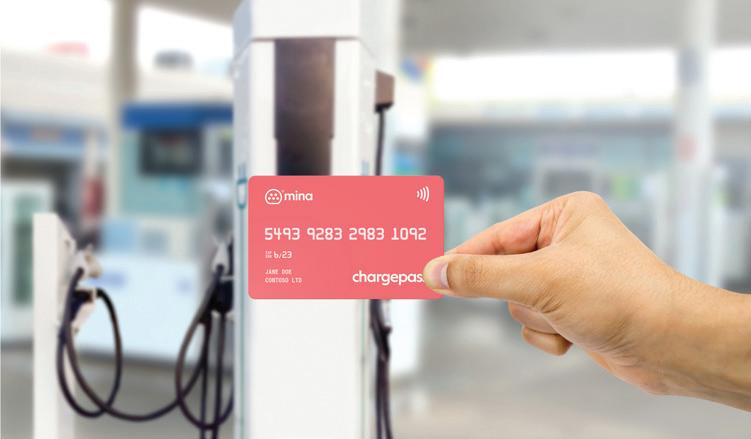
CHARGEPASS® FREE FOR THREE MONTHS www.ev eet.solutions
the sound of
another challenge.
you can manage the risk to your drivers and your business by investing in world-class fleet consultancy, driver assessment and training. Something we’ve been providing to businesses worldwide for over 30 years.
part of the AA too,
we know it makes a real difference to you that your drivers have the knowledge and experience
important to
let’s work
be the amongst the safest on the road.
vision
make our roads safer for everyone.
reduce costs and save lives.

That’s
your company’s reputation hitting
But
We’re
so
to
It’s
us because it’s our
to
So
together to protect your reputation,
World-class driver assessment and training Safer Drivers. Safer Roads. www.drivetech.co.uk/saferdrivers email: tellmemore@drivetech.co.uk 01256 610907
Our industry can be physically and mentally tough. Together with our partners and supporters, the Lighthouse Construction Industry Charity are working night and day to ensure that no construction worker or their family feels alone in a crisis. So if you or a workmate need support, we are always here to help.



He was our big mouth - he’d always have an answer for everything, except for why he should still be here.
Registered Charity No. UK 1149488 | Registered Charity No. ROI 20200334.Company No. 08244118 | Copyright Lighthouse Construction Industry Charity 2021.
The best kept secret. Until now.
The best kept secret. Until now.
14 The Standard Summer 2021
FIRST DRIVE: VOLTA ZERO 16-TONNER
Start-up manufacturer Volta Trucks is styling itself as a disrupter in the electric truck sector. First formed back in 2019 by founder Carl-Magnus Norden, Volta has been working up prototypes of its Volta Zero – a 16-tonne, two-axle all-electric rigid aimed squarely at city distribution.
Words: James Baker
Built from the ground up, Volta Zero has a futuristic look and is seeking to do a number of things differently to other manufacturer’s electric vehicles. This bravery seems to be paying off, as some big-name operators including DB Schenker and Petit Forestier have already put in significant orders.
Volta’s roadmap sees customer testing commence early next year before an official launch of 16- and 18-tonne variants in London and Paris a few months later. Wider launches across Europe and the US will happen shortly afterwards, ahead of the launch of 7.5- and 12-tonne models towards the end of 2024. Volta’s initial goal is to place 22,500 vehicles with operators across Europe and North America by 2025.

The 16-tonne Zero quotes a range of up to 200 km (124 miles) per charge. It can be fitted with two or three 75 kWh Proterra battery packs delivering 150-225 kWh of power. It measures 9200 mm in length, 3470 mm high and 2550 mm wide. Its wheelbase is 4800 mm with a turning circle of 14 m. Production models will be manufactured in Austria by Steyr Automotive.
Rather than bolting electric motors to a common gearbox and driveline, Volta is the first commercial vehicle maker in Europe to use an eAxle from Meritor. This single unit combines electric motor, transmission and rear axle to deliver power directly to the rear wheels. Volta reckons this is lighter and more efficient than a conventional electric motor and axle setup, which can help increase operational range. It also frees up space between the chassis rails, so batteries can be mounted centrally between the rails for better impact protection.
Zeros can be ordered with either ambient or refrigerated bodies. The former are built by Paneltex and give a payload of up to eight tonnes and room for 16 Euro pallets.
42 destination net zero | issue 2
Chilled models are made by Lecapitaine and can carry up to 15 Euro pallets, with a payload of up to seven tonnes. They use Iceland refrigeration units from Carrier Transicold. Dhollandia tail-lifts can also be fitted to both models.
With a clear target of achieving a five-star Direct Vision Standard (DVS) rating in London, Volta has built a unique cab concept with oversize windows, large glass panels mounted in busstyle sliding doors, and a low central driving position. All this combines to give the driver 220 degrees of eye-level direct visibility.
The Zero also packs a lot of extra tech to further reduce blind spots and increase safety. These include digital side-view cameras, a 360-degree bird’s-eye camera showing a complete image of the truck’s surroundings, and blind-spot warning systems that detect objects at the sides of the vehicle.
Driving impressions
We were recently invited to the UTAC test track on the outskirts of Paris to take a first drive in one of the current batch of Zero design verification prototypes. Built in Coventry by Astheimer, there are currently 25 prototypes on Volta’s fleet and it’s worth bearing in mind some details will change ahead of series production.

This, of course, makes them hard to evaluate – but there’s still much to be learned from strapping into the unusual central driving seat and heading out onto the track.
The first thing to note is stepping aboard the Zero is similar to stepping onto a bus. It’s sliding doors are designed to give the driver easy entry from either side of the vehicle, and its low floor makes stepping in and out a cinch – a definite plus point for those on multi-drop work. Sliding doors also benefit the safety of other road users, as they won’t swing out into the path of traffic, pedestrians or cyclists.
issue 2 | destination net zero 43 cont.
“As expected, visibility from the driver’s seat is excellent.”
Sitting inside the cab feels a bit like sitting on the bridge of the Starship Enterprise. There are screens everywhere – one on either side of the driver giving access to ancillary equipment controls and infotainment; two large monitors on the corner pillars taking the place of traditional glass mirrors; a large dash panel behind the wheel for driving information etc; and even a small screen above the driver’s head acting like a car-style rear-view mirror.
There are some physical controls. Beneath the two side screens are buttons giving analogue control of door release, interior lights, fog lights, central locking, hill hold and transmission controls.
Pulling out onto the test track, it’s immediately clear sitting in the middle of the cab will take some getting used to. We’ve driven lots of left- and right-hand drive trucks and are not usually fazed by the change of perspective, but we found sitting centrally initially caused us to drift across the lane as if subconsciously aligning ourselves with the middle line of the track. We soon got the hang of it, but it’s something to keep in mind.
Like all other electric trucks we’ve driven, the Zero gives a quiet, yet punchy performance when you press the pedal. The eAxle feels sprightly and the truck soon gets up to speed – though it must be noted we were not carrying a load. It will be interesting to see how the Zero performs when pulling a full cargo, but we’ll have to wait a bit longer before we can form a full opinion.


As expected, visibility from the driver’s seat is excellent. The large glass panels in the doors open the sides right up, so drivers should have far fewer problems seeing cyclists pulled up alongside. However, we felt a bit exposed sitting so low down and without much of a forward assembly to protect us from a head-on impact. We look forward to digging into the safety credentials of the final production model.
There’s also a question mark over interior storage. Our test truck had seats positioned behind the driver’s right and left shoulders, so the only places available for stowing gear were bottle/paperwork holders either side of driver’s seat. We are told production vehicles will have overhead lockers, so again we’ll wait and see.
Overall though, the Zero gave a positive impression. Once we were used to the driving position, we could relax and really enjoy our laps around the track. We have questions about the final spec and hope interior storage can be beefed up, but for now we’ll look forward to getting behind the wheel again once full production is under way.
end


44 destination net zero | issue 2
end
SPECIFICATION
Model: Volta Zero

Design gvw: 16,000 kg
Chassis: Front axle: 6,500 kg capacity. Rear axle: 11,000 kg capacity. 4800 mm wheelbase. Full air suspension. Max payload: 7750 kg
Engine: Electric Meritor eAxle
Battery size: Up to 246 kWh gross, 225 kWh usable
Range: Up to 200 km/124 miles per charge


Additional equipment: Three seats including central driving seat, ambient box body with roller doors, low-entry cab with sliding doors

issue 2 | destination net zero 45
• Three seats including central driving seat
• The Zero also packs a lot of extra tech
Building electric utility vehicles for 25 years, the latest and the largest model in the range offers a generous payload of up to 1,050kg for the pick-up and an impressive 9m3 for the cage body. With a vast array of body options, the Goupil G6 is suitable for various business needs and applications whilst delivering environmental and sustainable operations. Designed to fulfil everyday tasks, the 100% electric G6 comes with a 28.8kWh lithium battery providing a 93-mile range.*
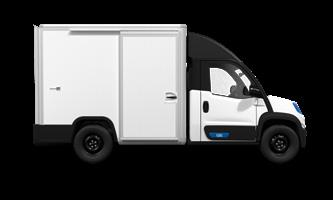
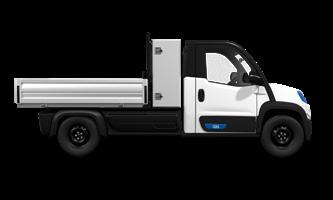
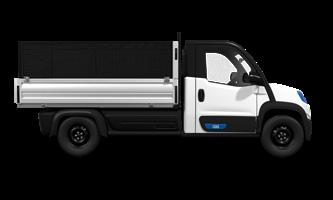
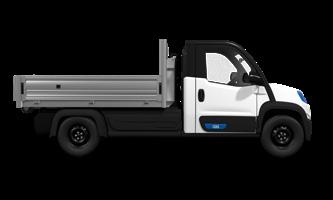



THE NEW GOUPIL G6 100% ELECTRIC ZERO EMISSIONS
SALES@BRADSHAWEV.COM | 01780 782 621 WWW.BRADSHAWEV.COM/GOUPIL-ROAD-VEHICLES *Range measured in accordance with the Worldwide Harmonised Light Vehicle Test Procedure (WLTP)
The zero-emission distribution truck


the answer. It not only offers zero emissions
If you’re looking for a
almost
also has
That’s unique in this class! What’s more, it gives you
the
come
expect
Easy cab access,
Electric gives you the best of both
A PACCAR COMPANY DRIVEN BY QUALITY DAF LF ELECTRIC
fully electric distribution truck, the DAF LF Electric is
and
silent driving, it
a range of up to 280 kilometres.
all
benefits you’ve
to
from the DAF LF.
unparalleled manoeuvrability and a low kerb weight for a high payload. The DAF LF
worlds. It’s great for the environment and your business. Visit www.daf.com/lf-electric

MICHELIN Connected Fleet services and solutions provide the tools and information you need to manage and improve your fleet operations. As your partner, we provide intelligent recommendations based on your data to reduce costs, improve productivity, ensure driver safety and manage sustainable fleets. • Connected fleet technology • Daily fleet management analysis tools • Smart report service and action plans connectedfleet.michelin.com fleet management. MASTERED.





































 Words: Backhouse Jones
Words: Backhouse Jones









































































































